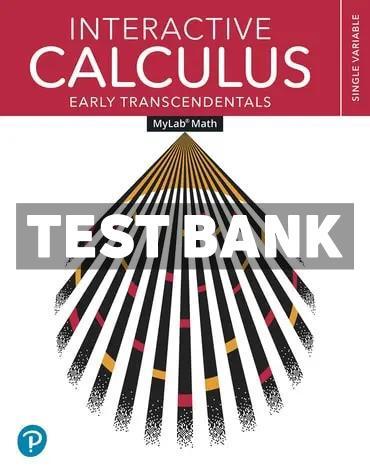
MULTIPLE CHOICE. Choose the one alternative that best completes the statement or answers the question.
Find the domain and range of the function.
1) f(x) = -4 - x2
A) D: (, -4], R: (, )
B) D: (, ), R: (, )
C) D: (, ), R: [-4, )
D) D: (, ), R: (, -4] Answer: D
2) F(t) = t2 - 5
A) D: (, ), R: [-5, )
B) D: [-25, ), R: [-5, )
C) D: (, ), R: (, )
D) D: [0, ), R: (, -5] Answer: A
3) g(z) = -7 - z
A) D: (- ,0], R: [-7, )
B) D: (, -7], R: (, )
C) D: (, ), R: (, -7]
D) D: [0, ), R: (, -7] Answer: D
4) f(x) = + x
A) D: [0, ), R: [ , )
B) D: (, ), R: [ , )
C) D: [0, ), R: (, )
D) D: (- ,0], R: (, ] Answer: A
5) F(t) = 5 t
A) D: [0, ), R: (, )
B) D: (- ,0), R: (- ,0)
C) D: (, ), R: (, )
D) D: (0, ), R: (0, ) Answer: D
6) g(z) = -9 z + 1
A) D: [0, ), R: (, )
B) D: (-1, ), R: (- ,0)
C) D: [1, ), R: (, )
D) D: (, -1), R: (0, ) Answer: B
7) f(x) = 6
9 + x
A) D: [0, ), R: (, )
B) D: (, ), R: 0, 2 3
C) D: (- ,0], R:(- ,0]
D) D: [0, ), R: 0, 2 3
Answer: D
8) F(t) = 6 5 t
A) D: [0, ), R: [0, )
B) D: (, ), R: (, )
C) D: (0, ), R: (0, )
D) D: (- ,0), R: (- ,0)
Answer: C
9) g(z) = 1 - z2
A) D: (, ), R: (0, 1)
B) D: (-1,1), R: (-1,1)
C) D: [0, ), R: (, )
D) D: [-1,1], R: [0,1]
Answer: D
Determine whether or not the graph is a graph of a function of x. 10)

A) Function
B) Not a function
Answer: A
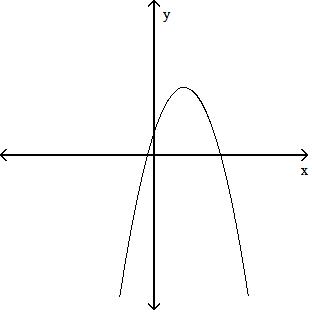
A) Not a function
B) Function
Answer: B

A) Not a function
B) Function
Answer: A 13)

A) Function
B) Not a function
Answer: B

A) Function
B) Not a function
Answer: A
15)

A) Not a function
B) Function
Answer: B
Find the formula for the function.
16) Express the perimeter of a square as a function of the square's side length x.
A) p = 3x 2
B) p = 4x
C) p = x3
D) p = 6x
Answer: B
17) Express the area of a square as a function of its side length x.
A) A = 2x
B) A = 4x
C) A = x2
D) A = x4
Answer: C
18) Express the length d of a square's diagonal as a function of its side length x.
A) d = x 2
B) d = x
C) d = 2x
D) d = x 3
Answer: A
19) Express the perimeter of an isosceles triangle with side lengths x, 5x, and 5x as a function of the side length.
A) p = 10x3
B) p = 10x
C) p = 11x
D) p = 25x3
Answer: C
20) Express the area of a circle as a function of its radius r.
A) A = r
B) A = r3
C) A = r2
D) A = 2 r
Answer: C
21) Express the volume of a sphere as a function of its radius r.
A) V = 2 3 r2
B) V = 3 4 r3
C) V = r3
D) V = 4 3 r3
Answer: D
22) A point P in the first quadrant lies on the graph of the function f(x) = x2. Express the slope of the line joining P to the origin as a function of x.
A) m = 1 x
B) m = 2x
C) m = 2 x
D) m = x
Answer: D
23) A point P in the fourth quadrant lies on the graph of the function f(x) = -x2. Express the slope of the line joining P to the origin as a function of x.
A) m = 1 x
B) m = -x
C) m = -2x
D) m = x
Answer: B
Find the domain and graph the function. 24) f(x) = 7x - 3

A) D: (, )




Answer: B




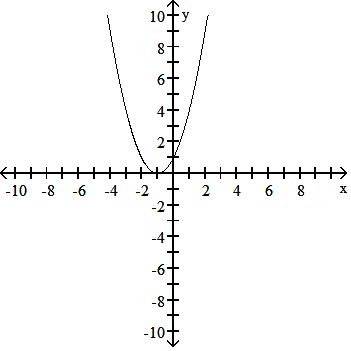
Answer: A
F(x) = -x

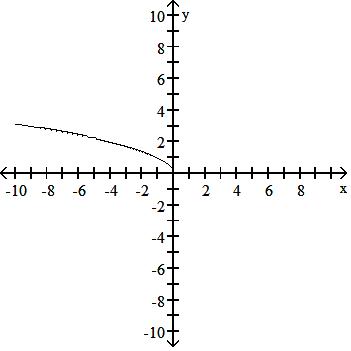

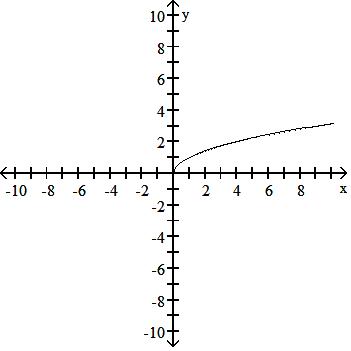

Answer: B





Answer: C

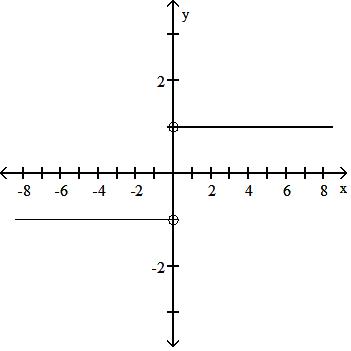
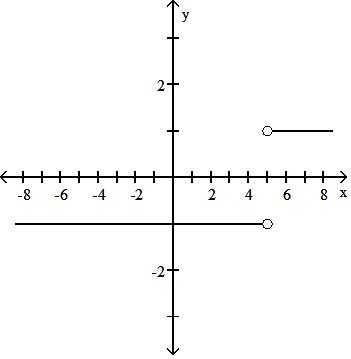
D: (, 5) (5>, )
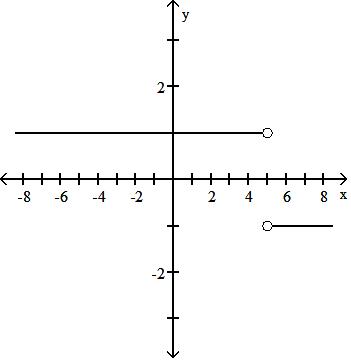

Answer: B
29) G(t) = 1 t - 2
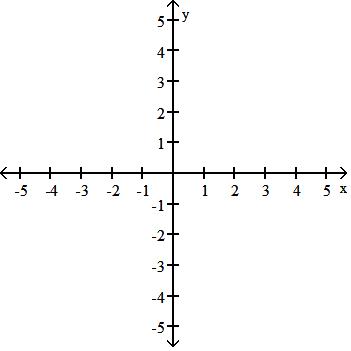
D: (, ) ( , )



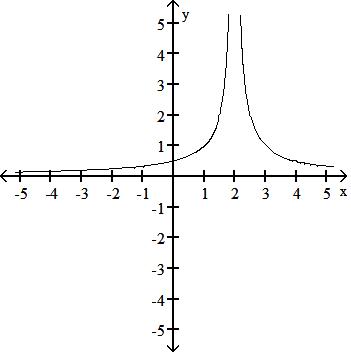
Answer: D
Graph the function.
30) f(x) = -1 - x, x < 1 -4, x 1
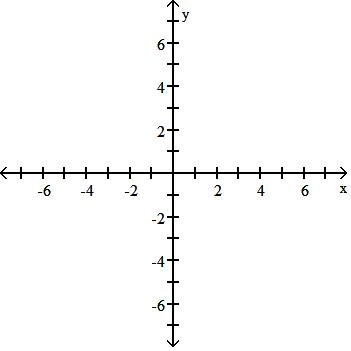
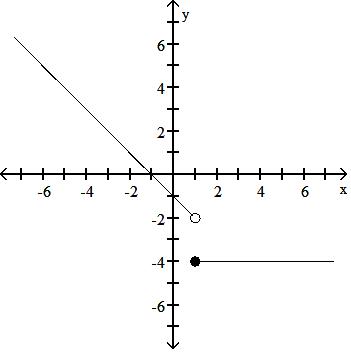
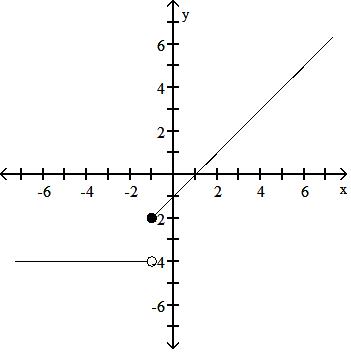
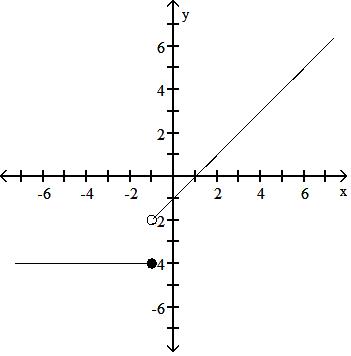
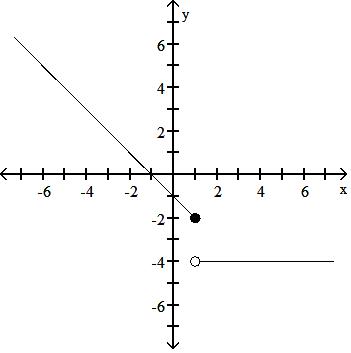
Answer: A


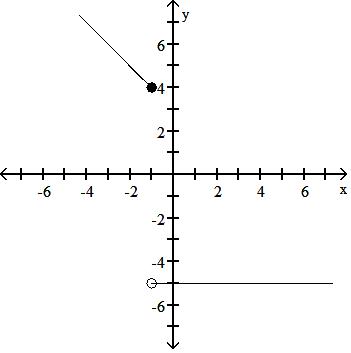

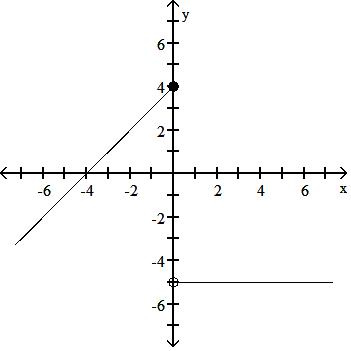
Answer: C
32) F(x) = 2 - x, x 2 1 - 3x, x > 2



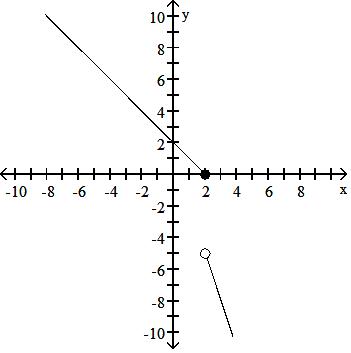

Answer: C


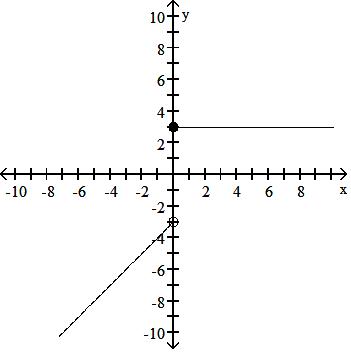

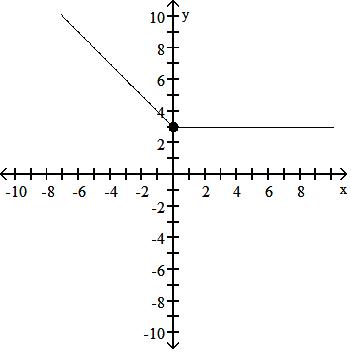
Answer: D
34) f(x) = 5x + 2, x < -2 x, -2 x 3 4x - 1, x > 3
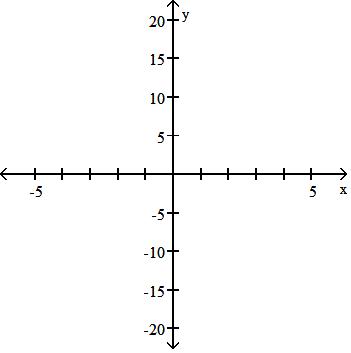


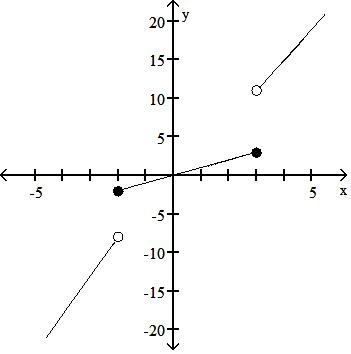

Answer: C
35) g(x) = 1 x + 1 , x < -1 x, x -1
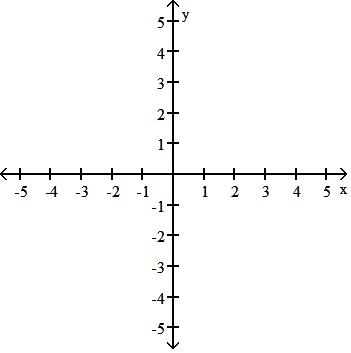
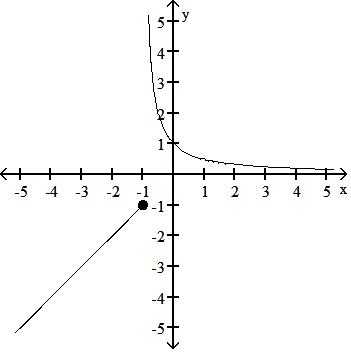
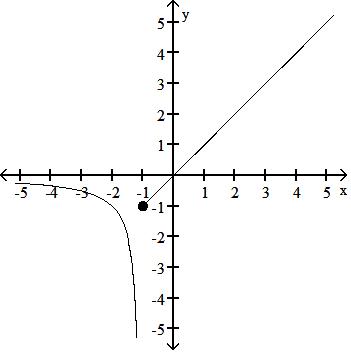
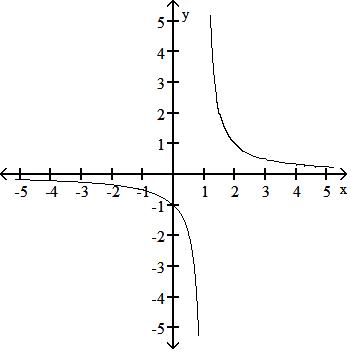
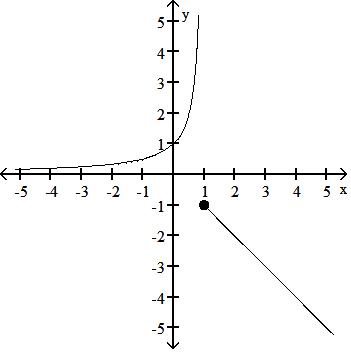
Answer: B
Find a formula for the function graphed. 36)

A) f(x) = 4, -4, x < 0 x 0
B) f(x) = -4, 4, x 0 x > 0
C) f(x) = 4x, -4x, x 0 x > 0
D) f(x) = 4, -4, x 0 x > 0
Answer: D

A) f(x) = 3, x, x < 0 x 0
B) f(x) = 3, -x, x < 0 x 0
C) f(x) = 3, -x, x 0 x > 0
D) f(x) = 3, -3x, x < 0 x 0
Answer: B
38)

A) f(x) = 3, x < 3 x - 3, x 3
B) f(x) = 3, x < 3 3 - x, x > 3
C) f(x) = 3, x 3 3 - x, x > 3
D) f(x) = 3, x < 0 3 - x, x 0
Answer: C
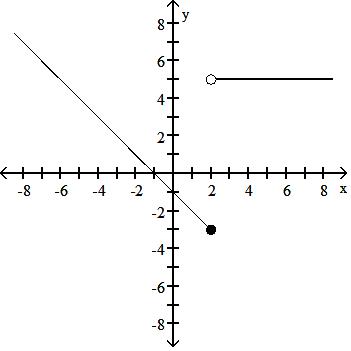
A) f(x) = -1 + x, x < 2
5 x > 2
B) f(x) = -1 + x, x 2 5 x > 2
C) f(x) = -1 - x, x < 2
5 x 2
D) f(x) = -1 - x, x 2 5 x > 2
Answer: D

A) f(x) = x, x 1 2x + 1, x > 1
B) f(x) = -2x, x 1 x + 2, x > 1
C) f(x) = -2x, x 1 x + 1, x > 1
D) f(x) = 2x, x 1 x + 1, x > 1
Answer: C
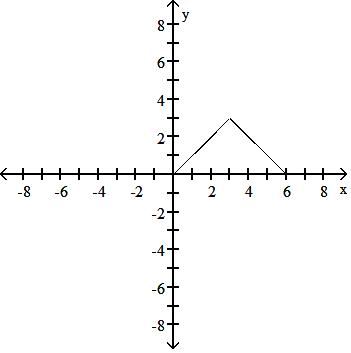
A) f(x) = -x, 0 x 3
x + 6, 3 < x 6
B) f(x) = x + 6, 0 x 3 -x, 3 < x 6
C) f(x) = 6 - x, 0 x 3
x, 3 < x 6
D) f(x) = x, 0 x 3
6 - x, 3 < x 6
Answer: D
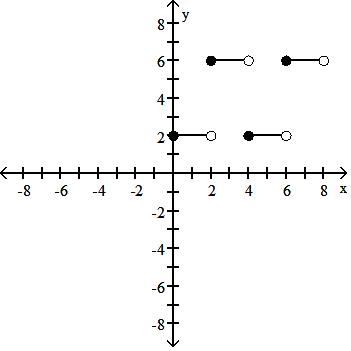
A) f(x) = 6, 0 x < 6
2, 2 x < 8
B) f(x) = 2, 0 x 2 6, 2 < x 4
2, 4 < x 6
6, 6 < x 8
C) f(x) = 2, 0 x < 6
6, 2 x < 8
D) f(x) = 2, 0 x < 2
Answer: D
6, 2 x < 4
2, 4 x < 6
6, 6 x < 8
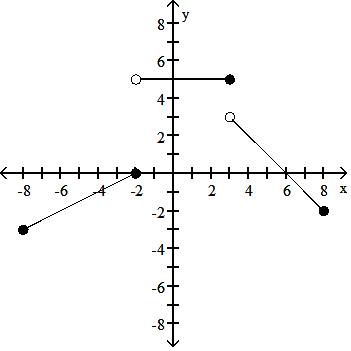
A) f(x) = 1 2 x + 1, -8 x -2
5, -2 < x < 3
6 - x, 3 x 8
B) f(x) =1 2 x + 1, -8 x -2
5, -2 < x 3 x - 6, 3 < x 8
C) f(x) = 1 2 x + 1, -8 < x -2
5, -2 < x 3
6 - x, 3 < x < 8
D) f(x) = 1 2 x + 1, -8 x -2
5, -2 < x 3
6 - x, 3 < x 8
Answer: D
Graph the function. Determine the symmetry, if any, of the function.
44) y = 1 x3

A) Symmetric about the y-axis

B) No symmetry

C) Symmetric about the origin
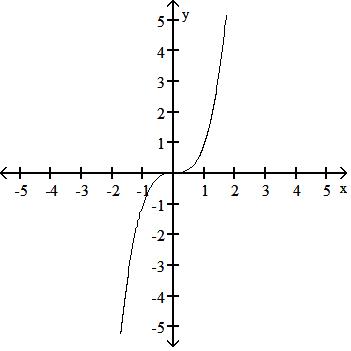
D) Symmetric about the origin

Answer: D
45) y =1 x2

A) Symmetric about the y-axis
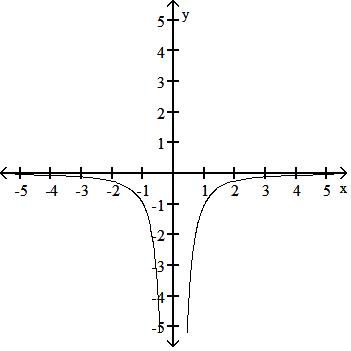
B) Symmetric about the y-axis

C) Symmetric about the y-axis
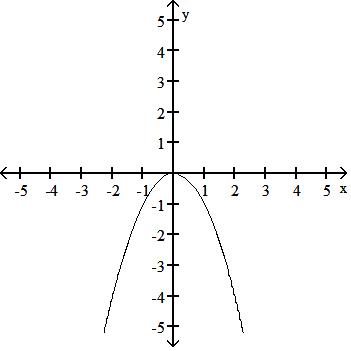
D) No symmetry
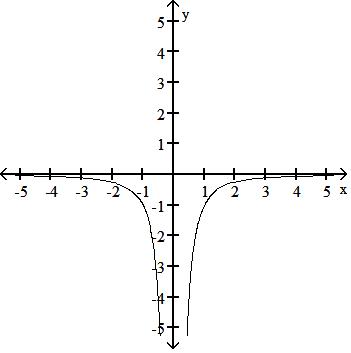
Answer: A

A) Symmetric about the origin
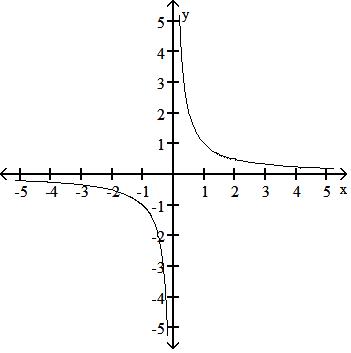
B) Symmetric about the origin
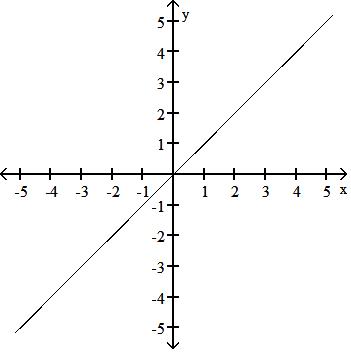
C) No symmetry

D) Symmetric about the origin
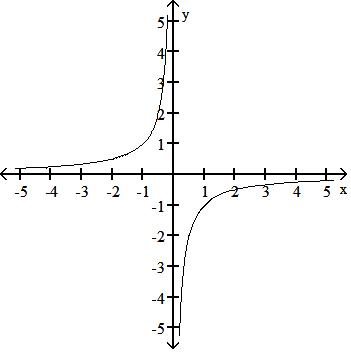
Answer: A
47) y = -|x|

A) Symmetric about the origin

B) Symmetric about the y-axis
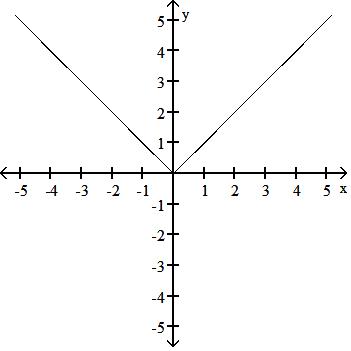
C) Symmetric about the y-axis

D) Symmetric about the x-axis

Answer: C
48) y = -x

A) No symmetry
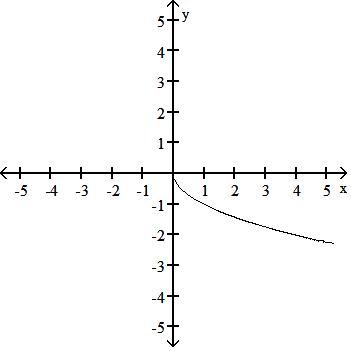
B) No symmetry
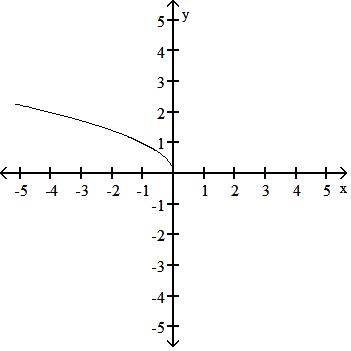
C) Symmetric about the y-axis
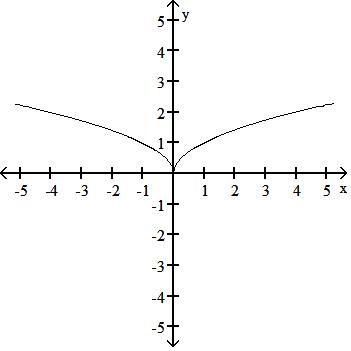
D) Symmetric about the y-axis

Answer: B
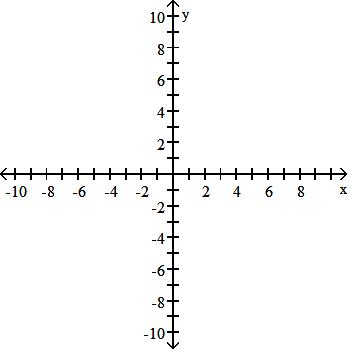
A) No symmetry
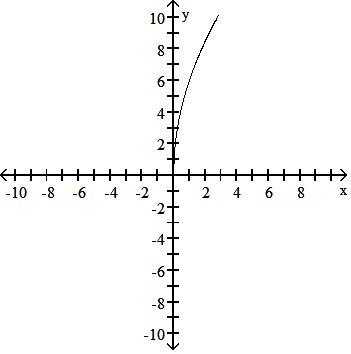
B) Symmetric about the x-axis

C) Symmetric about the x-axis
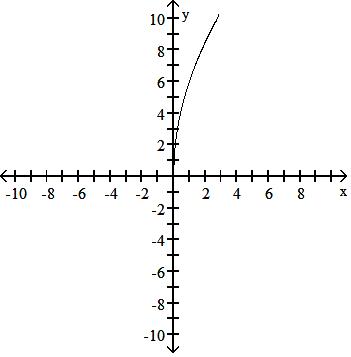
D) No symmetry
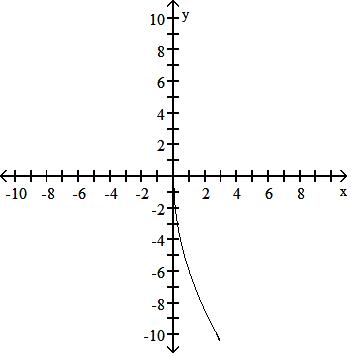
Answer: A
50) y = (-x)3/2

A) Symmetric about the y-axis

B) No symmetry

C) Symmetric about the y-axis

D) No symmetry

Answer: D

A) No symmetry

B) Symmetric about the y-axis

C) Symmetric about the y-axis
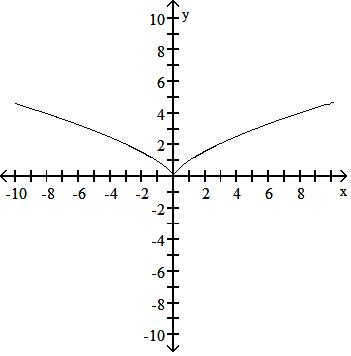
D) No symmetry

Answer: B
Graph the function. Specify the intervals over which the function is increasing and the intervals where it is decreasing.

A) Decreasing - < x < 0 and 0 < x <

B) Increasing - < x < 0 and 0 < x <

C) Increasing - < x <

D) Decreasing - < x < 0; Increasing 0 < x <

Answer: A
53) y =1 x2

A) Decreasing - < x < 0 and 0 < x <

B) Decreasing - < x < 0
Increasing 0 < x <

C) Increasing - < x < 0
Decreasing 0 < x <

D) Increasing - < x < 0 and 0 < x <

Answer: B 54) y = 1 x

A) Increasing - < x < 0 Decreasing 0 < x <
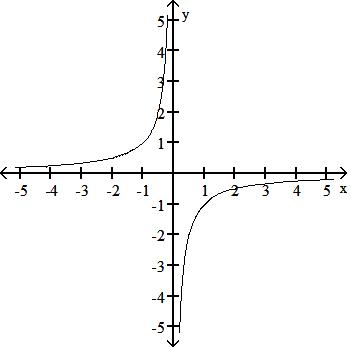
B) Decreasing - < x < 0 and 0 < x <

C) Decreasing - < x < 0 Increasing 0 < x <

D) Increasing - < x < 0 and 0 < x <

Answer: B

A) Increasing - < x 0
Decreasing 0 x <

B) Increasing - < x <

C) Decreasing - < x <

D) Decreasing - < x 0
Increasing 0 x <

Answer: A
56) y = -x

A) Increasing - < x 0

B) Decreasing - < x 0

C) Decreasing 0 x <

D) Decreasing - < x 0
Increasing 0 x <

Answer: B
57) y = -2 x

A) Decreasing 0 x <

B) Increasing 0 x <
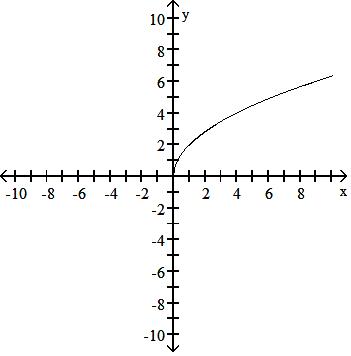
C) Decreasing - < x <

D) Increasing 0 x <

Answer: A

A) Decreasing - < x 0
Increasing 0 x <

B) Increasing 0 x <
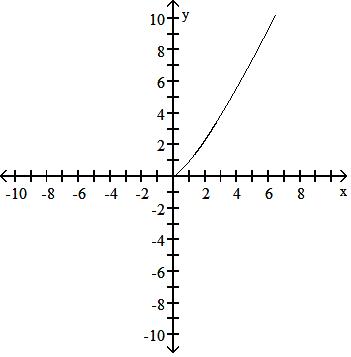
C) Decreasing - < x 0
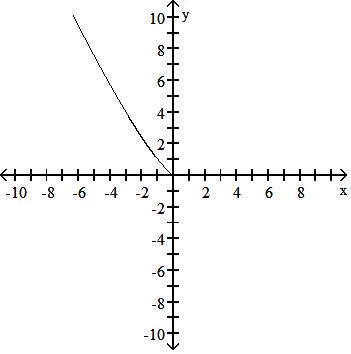
D) Decreasing - < x <
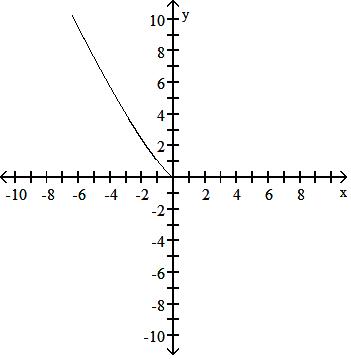
Answer: C
59) y = -x2/5

A) Decreasing - < x 0
Increasing 0 x <
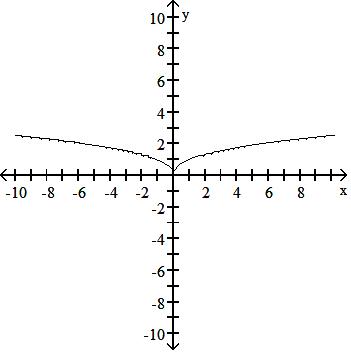
B) Increasing - < x < 0
Decreasing 0 < x <

C) Increasing - < x <

D) Decreasing - < x <

Answer: B
Determine if the function is even, odd, or neither.
60) f(x) = 1
A) Even
B) Odd
C) Neither Answer: A
61) f(x) = 2x2 + 4
A) Even
B) Odd
C) Neither Answer: A
62) f(x) = -4x4 + 7x + 5
A) Even
B) Odd
C) Neither Answer: C
63) f(x) = x5 + 9x3
A) Even
B) Odd
C) Neither Answer: B
64) f(x) = (x - 2)(x + 1)
A) Even
B) Odd
C) Neither Answer: C
65) f(x) = -9 x2 - 1
A) Even
B) Odd
C) Neither Answer: A
66) f(x) = 1 x + 4
A) Even
B) Odd
C) Neither Answer: C
67) g(x) = -3x x2 + 9
A) Even
B) Odd
C) Neither Answer: B
68) g(x) = |7x7|
A) Even
B) Odd
C) Neither Answer: A
69) h(t) = t2 + 6
A) Even
B) Odd
C) Neither Answer: A
Match the equation with its graph.
70) y = 4x
A)
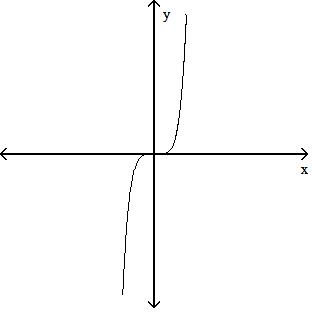
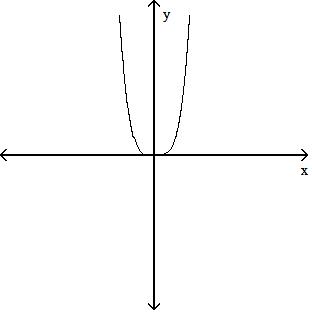
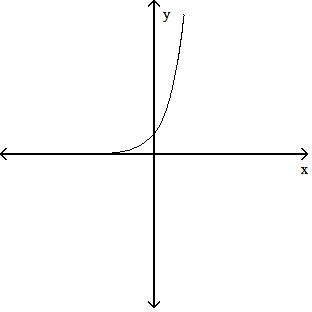

Answer: C
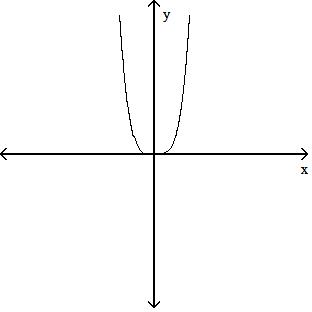



Answer: A 72) y = 4x
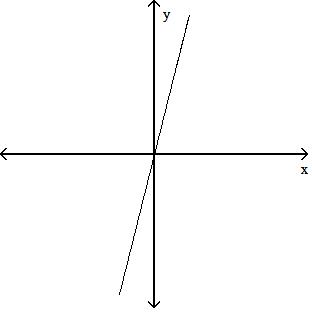



Answer: A
Provide an appropriate response.
73) Graph the functions f(x) = x 2 and g(x) = 3 + 8 x together to identify the values of x for which x 2 > 3 + 8 x .
Confirm your findings algebraically.
A) (, -2) (0, 8)
B) (-2, 0) (8, )
C) (-2, 8)
D) (8, )
Answer: B
74) Graph the functions f(x) = 6 x - 1 and g(x) = 4 x + 1 together to identify the values of x for which 6 x - 1 < 4 x + 1
Confirm your findings algebraically.
A) (-5, )
B) (-5, -1) (1, )
C) (-1, 1) (1, )
D) (, -5)
Answer: D
Solve the problem.
75) The variable s is proportional to t, and s = 30 when t = 120. Determine t when s = 55
A) 210
B) 275
C) 4
D) 220
Answer: D
76) The kinetic energy K of a mass is proportional to the square of its velocity v. If K = 7,840 joules when v = 14 m/sec, what is K when v = 10 m/sec?
A) 4,000 joules
B) 3,000 joules
C) 4,500 joules
D) 5,000 joules
Answer: A
77) Boyle's Law says that volume V of a gas at constant temperature increases whenever the pressure P decreases, so that V and P are inversely proportional. If P = 12.7 lbs/in2 when V = 800 in3, then what is V when P = 25 lbs/in2?
A) 127 320 in3
B) 2032 5 in3
C) 200000 127 in3
D) 320 127 in3
Answer: B
78) A box with an open top is to be constructed from a rectangular piece of cardboard with dimensions 15 inches by 25 inches by cutting out equal squares of side x at each corner and then folding up the sides as in the figure. Express the volume V of the box as a function of x.
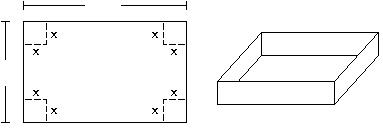
A) V(x) = x(15 - x)(25 - x)
B) V(x) = (15 - x)(25 - x)
C) V(x) = (15 - 2x)(25 - 2x)
D) V(x) = x(15 - 2x)(25 - 2x)
Answer: D
79) The figure shown here shows a rectangle inscribed in an isosceles right triangle whose hypotenuse is 10 units long. Express the area A of the rectangle in terms of x. -5 5

A) A(x) = x(5 - x)
B) A(x) = 2x(5 - x)
C) A(x) = 2x(x - 5)
D) A(x) = 2x2
Answer: B
80) A power plant is located on a river that is 600 feet wide. To lay a new cable from the plant to a location in a city 1 mile downstream on the opposite side costs $175 per foot across the river and $125 per foot along the land. Suppose that the cable goes from the plant to a point Q on the opposite side that is x feet from the point P directly opposite the plant. Write a function C(x) that gives the cost of laying the cable in terms of the distance x.
1 mi
600 ft
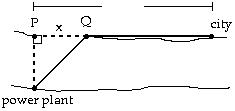
A) C(x) = 175 x2 + 6002 + 125(1 - x)
B) C(x) = 125 x2 + 6002 + 175(5280 - x)
C) C(x) = 175(600 - x) + 125(1 - x)
D) C(x) = 175 x2 + 6002 + 125(5280 - x)
Answer: D
Provide an appropriate response.
81) Consider the function y = 11 x . Can x be negative?
A) Yes
B) No
Answer: A
82) Consider the function y = 11 x . Can x be greater than 0, but less than 1?
A) Yes
B) No
Answer: B
83) What is the domain of the function y = 11 x ?
A) (- , 0) (1, )
B) (, )
C) (0, 1]
D) (- , 0) [1, )
Answer: D
84) Graph the equation y2 = x and decide whether or not the graph represents a function of x.

A) Function
B) Not a Function
Answer: B
85) Graph the equation |x + y| = 1 and decide whether or not the graph represents a function of x.

A) Function
B) Not a Function
Answer: B
86) For what values of x is = 0?
A) -1 < x 0
B) -1 x < 0
C) 0 < x 1
D) 0 x < 1
Answer: D
87) For what values of x is = -2?
A) -2 x < -1
B) -3 x < -2
C) -3 < x -2
D) -2 < x -1
Answer: C
88) What real numbers x satisfy the equation = ?
A) {x|x real numbers}
B) {x|x = 0}
C) {x|x integers}
D)
Answer: C
89) Graph the function f(x) = .
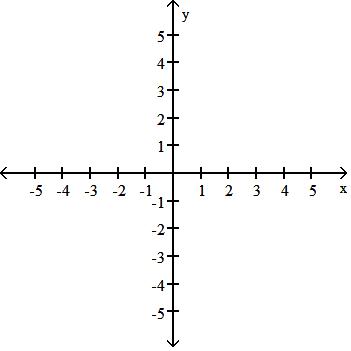
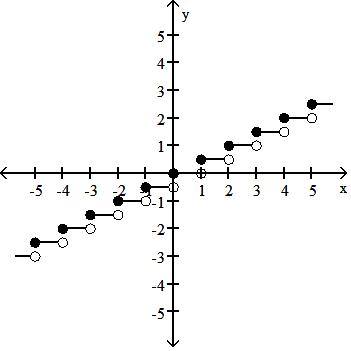
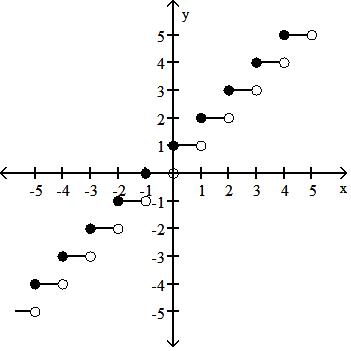
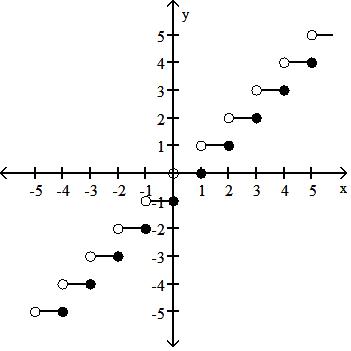
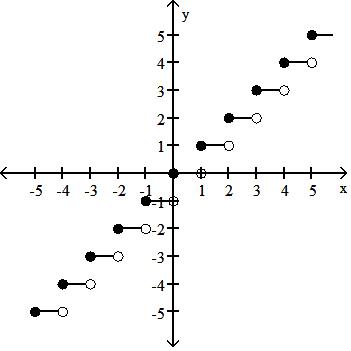
Answer: D
90) Graph the function f(x) =



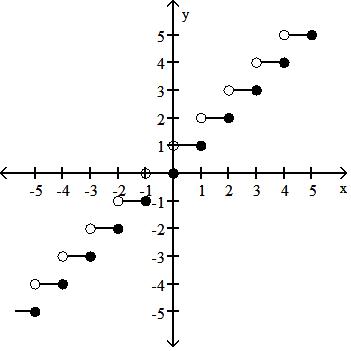

Answer: C
Find the domain and range for the indicated function.
91) f(x) = x + 11, g(x) = x - 11; f + g
A) D: x -11
R: y 0
B) D: x -11
R: y 22
C) D: x 11
R: y 0
D) D: x 11
R: y 22
Answer: D
92) f(x) = x + 5, g(x) = x - 5; g - f
A) D: x -5
R: y - 10
B) D: x 5
R: y 10
C) D: x 5
R: y 0
D) D: x 5
R: y - 10
Answer: D
93) f(x) = x + 2, g(x) = x - 2; f g
A) D: x 2
R: - < y <
B) D: x > 2
R: y 0
C) D: x 2
R: y 0
D) D: x 2
R: y > 0
Answer: C
94) f(x) = 7, g(x) = 7 + x; f/g
A) D: x 0
R: y 1
B) D: x 0
R: y 7
C) D: x 0
R: y 1
D) D: x -7
R: y 0
Answer: A
95) f(x) = 6, g(x) = 6 + x; g/f
A) D: x 0
R: y 1
B) D: x 0
R: y 1
C) D: x 0
R: y 6
D) D: x -6
R: y 0
Answer: A
Solve the problem.
96) If f(x) = 4x + 12 and g(x) = 2x - 1, find f(g(x)).
A) 8x + 16
B) 8x + 8
C) 8x + 11
D) 8x + 23
Answer: B
97) If f(x) = -2x + 6 and g(x) = 4x + 9, find g(f(x)).
A) 8x + 33
B) -8x - 15
C) -8x + 24
D) -8x + 33
Answer: D
98) If f(x) = x - 9 5 and g(x) = 5x + 9, find g(f(x)).
A) 5x + 36
B) x
C) x + 18
D)9 5
Answer: B
99) If f(x) = x + 5 and g(x) = 8x - 9, find f(g(x)).
A) 8 x + 5 - 9
B) 2 2x - 1
C) 8 x - 4
D) 2 2x + 1
Answer: B
100) If f(x) = 4x2 + 5x + 6 and g(x) = 5x - 5, find g(f(x)).
A) 4x2 + 5x + 1
B) 20x2 + 25x + 25
C) 20x2 + 25x + 35
D) 4x2 + 25x + 25
Answer: B
101) If f(x) = 1 x and g(x) = 7x3, find g(f(x)).
A) 7 x
B) 1 7x3
C) 7 x3
D) 1 x3
Answer: C
102) If f(x) = x - 4 and g(x) = -6x2 + 4x - 9, find g(f( )).
A) -79
B) -691
C) -31
D) -259
Answer: B
103) If f(x) = x + 1 and g(x) = x2 + 2x + 2, find g(f(-4)).
A) -181
B)
C)
D) -187
Answer: C
104) If f(x) = x, g(x) = x 5 , and h(x) = 5x+ 20, find f(g(h(x))).
A) x + 4
B) x + 4
C) x + 20
D) 5 x + 20
Answer: A
105) If f(x) = x, g(x) = x 5 , and h(x) = 5x+ 20, find h(g(f(x))).
A) 5 x + 20
B) x + 20
C) x + 4
D) x + 4
Answer: B
Express the given function as a composite of functions f and g such that y = f(g(x)).
106) y = 1 x2 - 9
A) f(x) = 1 x2 , g(x) =1 9
B) f(x) = 1 x , g(x) = x2 - 9
C) f(x) = 1 x2 , g(x) = x - 9
D) f(x) = 1 9 , g(x) = x2 - 9
Answer: B
107) y = 5x + 2
A) f(x) = x, g(x) = 5x + 2
B) f(x) = x , g(x) = 5x + 2
C) f(x) = - x , g(x) = 5x + 2
D) f(x) = -x , g(x) = 5x - 2
Answer: B
108) y = 9 x2 + 5
A) f(x) = x, g(x) = 9 x + 5
B) f(x) = 9 x2 , g(x) = 5
C) f(x) = 1 x , g(x) = 9 x + 5
D) f(x) = x + 5, g(x) = 9 x2
Answer: D
109) y = 2 3x + 8
A) f(x) = 2, g(x) = 3 + 8
B) f(x) = 3x + 8, g(x) = 2
C) f(x) = 2 x , g(x) = 3x + 8
D) f(x) = 2 x , g(x) = 3x + 8
Answer: C
110) y = (5x - 12)6
A) f(x) = x - 12, g(x) = x6
B) f(x) = x6, g(x) = x - 12
C) f(x) = x6, g(x) = 5x - 12
D) f(x) = ( x)6, g(x) = -12
Answer: C
Solve the problem.
111) Let f(x) = x x - 5 . Find a function y = g(x) so that (f g)(x) = x.
A) g(x) = 1 x - 5
B) g(x) = x - 5 5
C) g(x) = x(x - 5)
D) g(x) = 5x x - 1
Answer: D
112) Let f(x) = x - 7. Find a function y = g(x) so that (f g)(x) = x2 - 7
A) g(x) = x2 - 7
B) g(x) = x2
C) g(x) = x2 + 7
D) g(x) = 2x
Answer: B
113) Let g(x) = x. Find a function y = f(x) so that (f g)(x) = x .
A) f(x) = x2
B) f(x) = 1 x2
C) f(x) = 1 x
D) f(x) = x
Answer: A
114) Let g(x) = x + 5. Find a function y = f(x) so that (f g)(x) = 3x + 15
A) f(x) = 3x + 5
B) f(x) = 3x - 5
C) f(x) = 3x
D) f(x) = 3(x + 1)
Answer: C
115) The accompanying figure shows the graph of y = x2 shifted to a new position. Write the equation for the new graph.
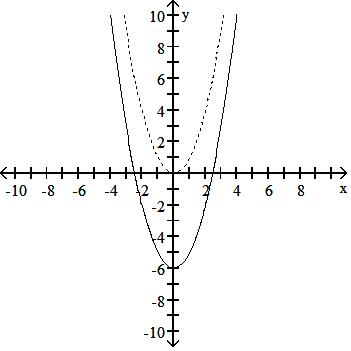
A) y = (x + 6)2
B) y = (x - 6)2
C) y = x2 + 6
D) y = x2 - 6
Answer: D
116) The accompanying figure shows the graph of y = x2 shifted to a new position. Write the equation for the new graph.

A) y = (x + 4)2
B) y = x2 - 4
C) y = x2 + 4
D) y = (x - 4)2
Answer: C
117) The accompanying figure shows the graph of y = x2 shifted to a new position. Write the equation for the new graph.
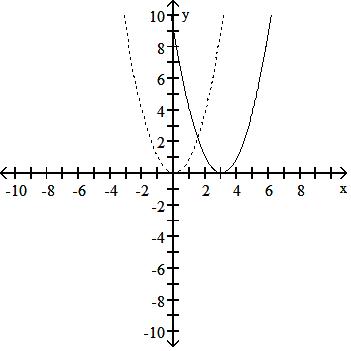
A) y = x2 - 3
B) y = (x + 3)2
C) y = x2 + 3
D) y = (x - 3)2
Answer: D
118) The accompanying figure shows the graph of y = x2 shifted to a new position. Write the equation for the new graph.

A) y = (x - 5)2
B) y = x2 + 5
C) y = x2 - 5
D) y = (x + 5)2
Answer: D
119) The accompanying figure shows the graph of y = -x2 shifted to a new position. Write the equation for the new graph.

A) y = -x2 - 5
B) y = -x2 + 5
C) y = -(x + 5)2
D) y = -(x - 5)2
Answer: A
120) The accompanying figure shows the graph of y = -x2 shifted to a new position. Write the equation for the new graph.
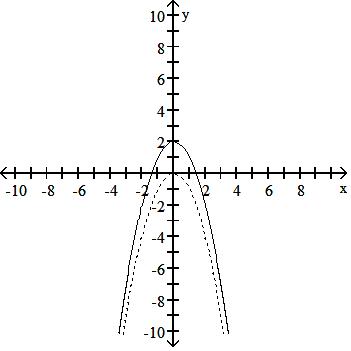
A) y = -x2 - 2
B) y = -x2 + 2
C) y = -(x + 2)2
D) y = -(x - 2)2
Answer: B
121) The accompanying figure shows the graph of y = -x2 shifted to a new position. Write the equation for the new graph.

A) y = -(x - 3)2
B) y = -(x + 3)2
C) y = -x2 - 3
D) y = -x2 + 3
Answer: A
122) The accompanying figure shows the graph of y = -x2 shifted to a new position. Write the equation for the new graph.

A) y = -x2 + 6
B) y = -(x - 6)2
C) y = -(x + 6)2
D) y = -x2 - 6
Answer: C
123) The accompanying figure shows the graph of y = x2 shifted to a new position. Write the equation for the new graph.
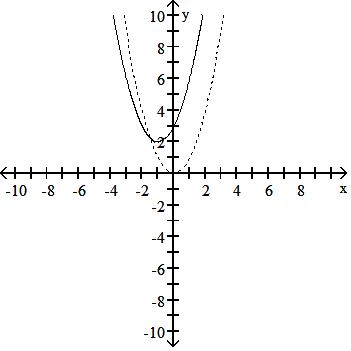
A) y = (x + 1)2 + 2
B) y = (x - 2)2 + 1
C) y = (x + 1)2 - 2
D) y = (x - 1)2 + 2
Answer: A
124) The accompanying figure shows the graph of y = -x2 shifted to a new position. Write the equation for the new graph.
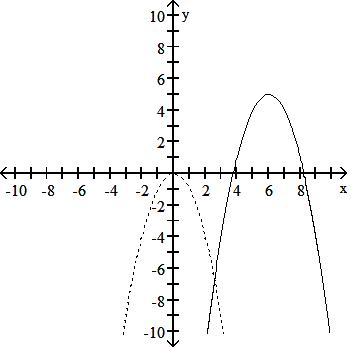
A) y = -(x + 6)2 + 5
B) y = -(x - 6)2 + 5
C) y = -(x - 6)2 - 5
D) y = -(x + 5)2 + 6
Answer: B
The problem tells how many units and in what direction the graph of the given equation is to be shifted. Give an equation for the shifted graph. Then sketch the original graph with a dashed line and the shifted graph with a solid line.
125) x2 + y2 = 9 Up 1, right 3

A) (x - 3)2 + (y - 1)2 = 9

B) (x - 3)2 + (y + 1)2 = 9
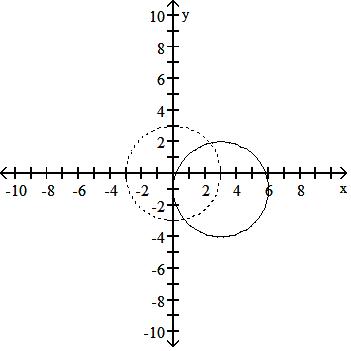
(x + 3)2 + (y - 1)2 = 9

(x + 3)2 + (y + 1)2 = 9
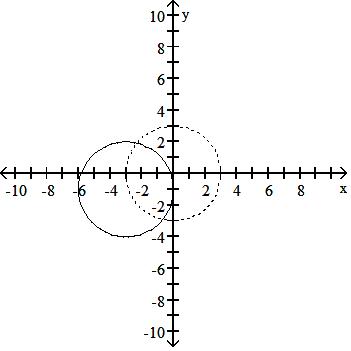
Answer: A
126) y = x3 Down 2, left 2

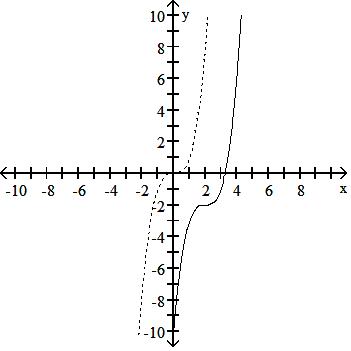
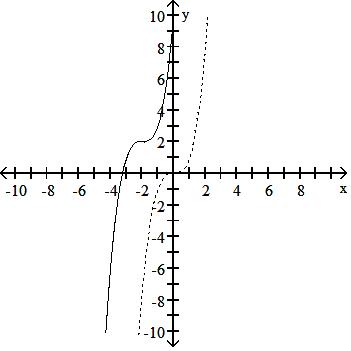
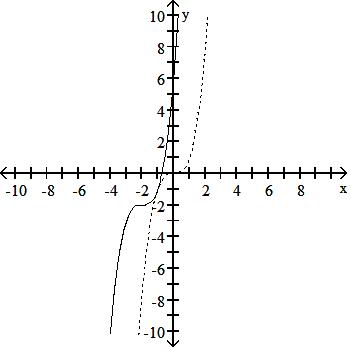

Answer: C



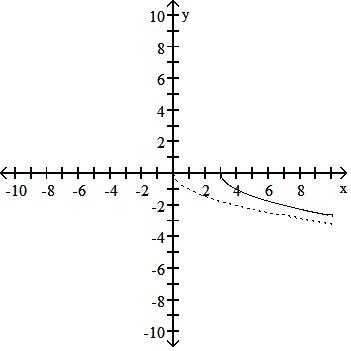

Answer: B
128) y = 1 x Down 4, right 1

y - 4 = 1 x + 1
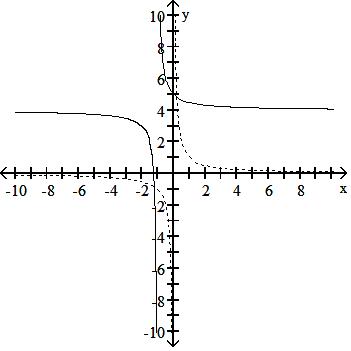
y + 4 = 1 x + 1

C) y - 4 = 1 x - 1
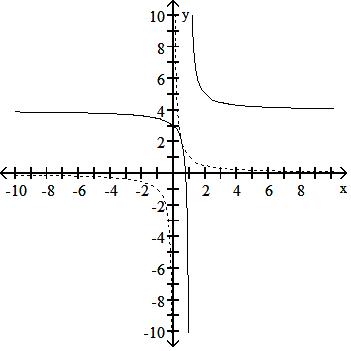
D) y + 4 = 1 x - 1

Answer: D
Graph the function.
129) y = x - 4 + 1

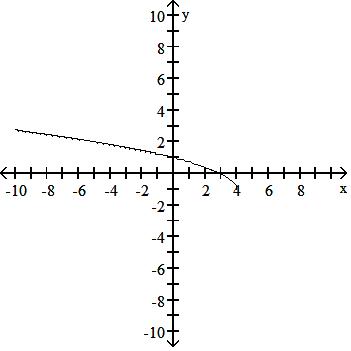
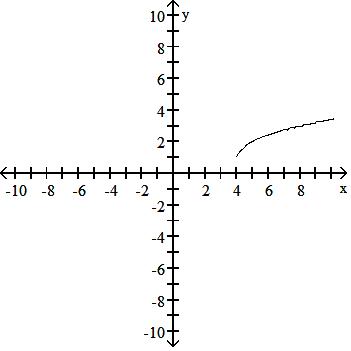
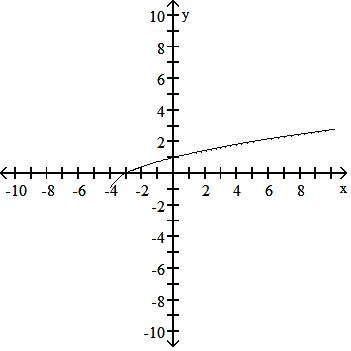
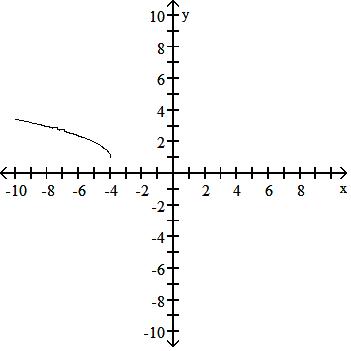
Answer: B

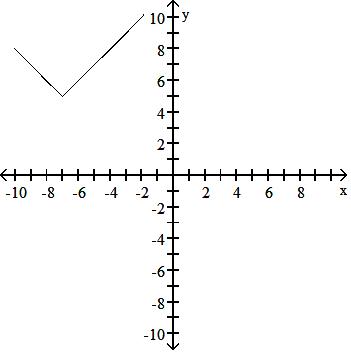
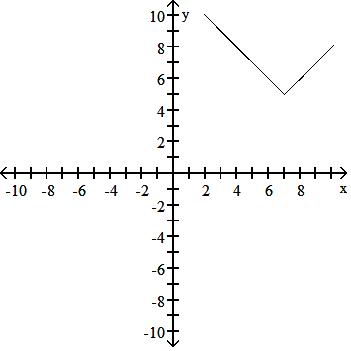
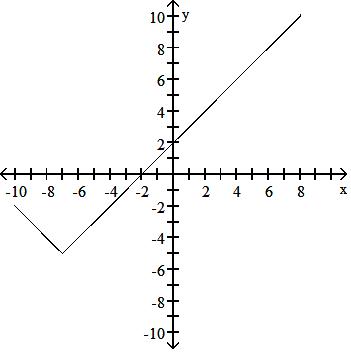

Answer: C

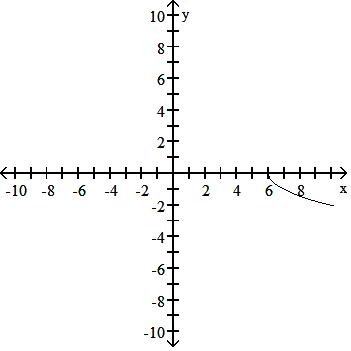

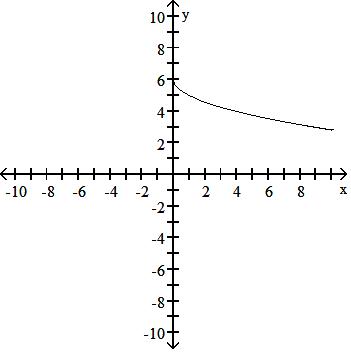
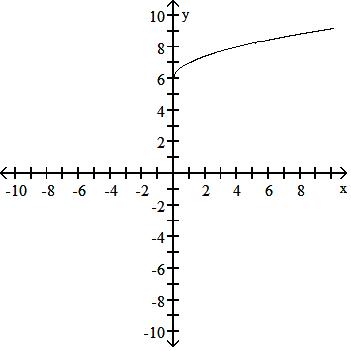
Answer: C


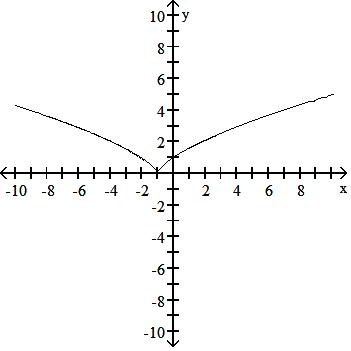

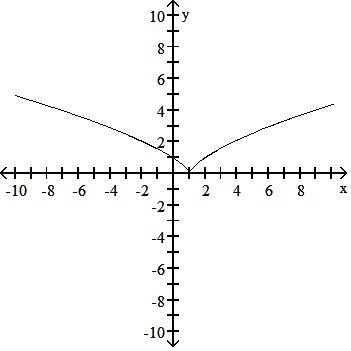
Answer: B


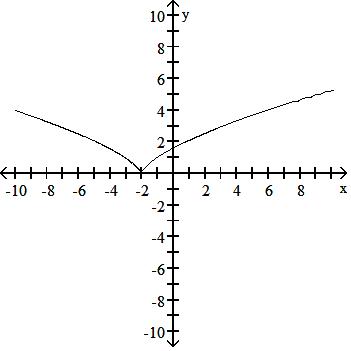
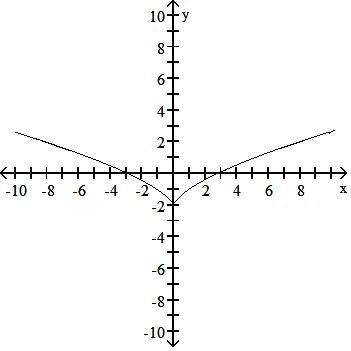
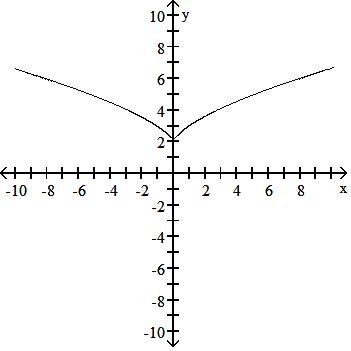
Answer: D

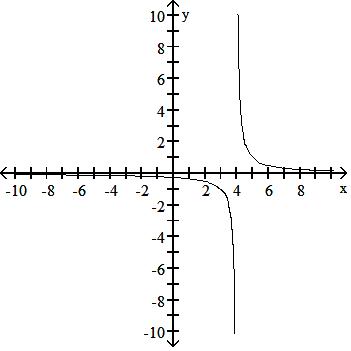
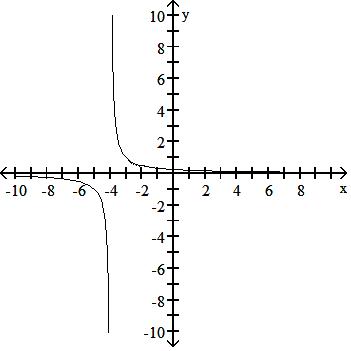
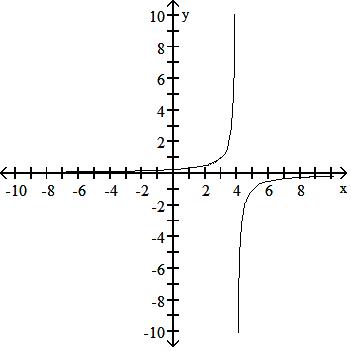
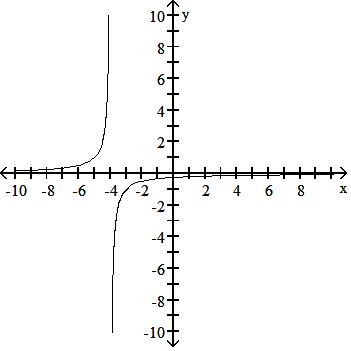
Answer: A 135) y = 1 x - 1

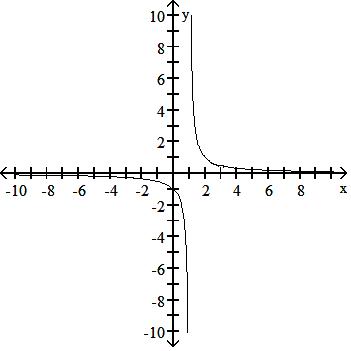

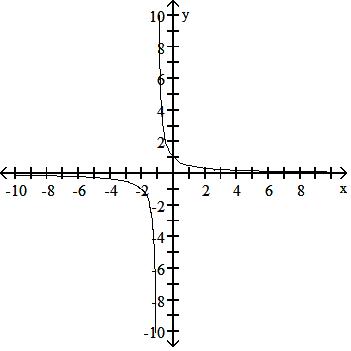
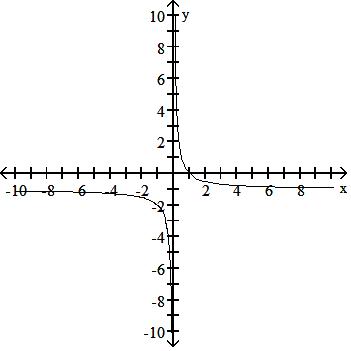
Answer: D


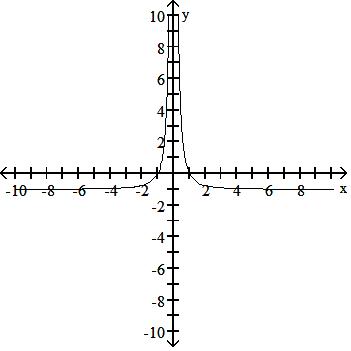

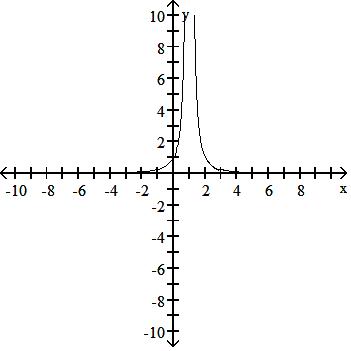
Answer: C


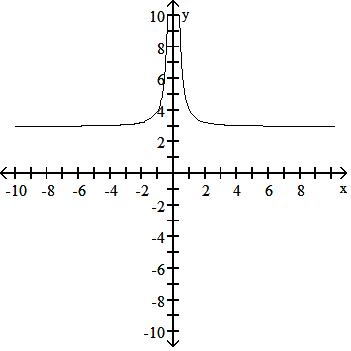

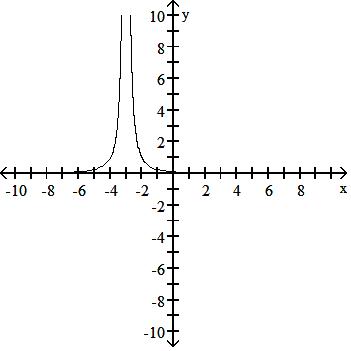
Answer: A


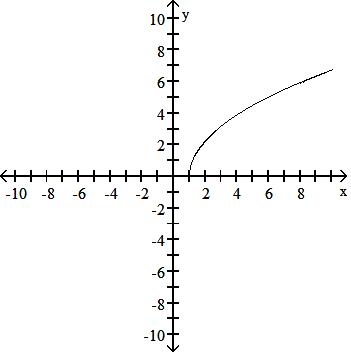


Answer: D



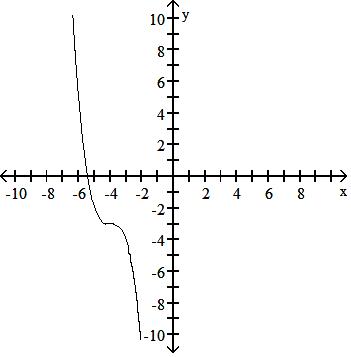
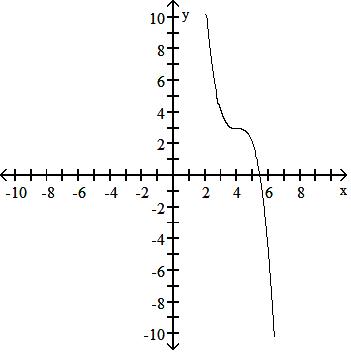
Answer: D


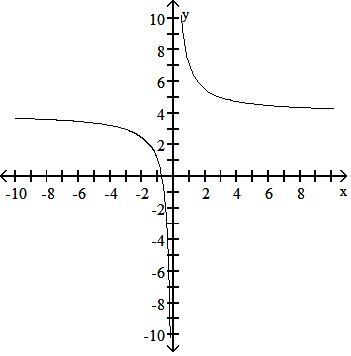

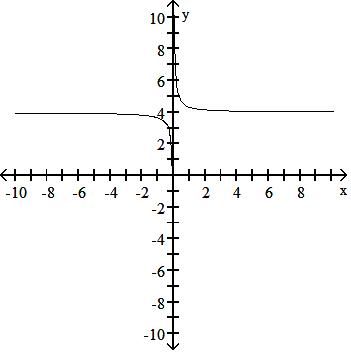
Answer: D





Answer: D

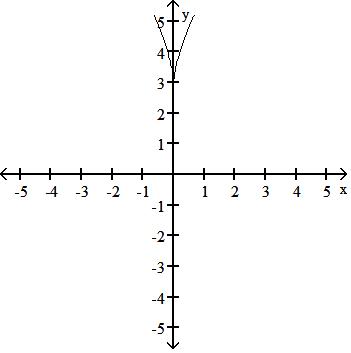
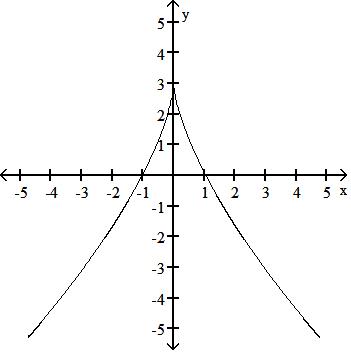
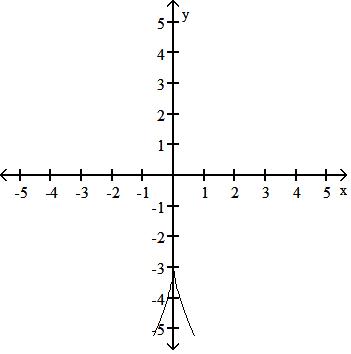

Answer: A


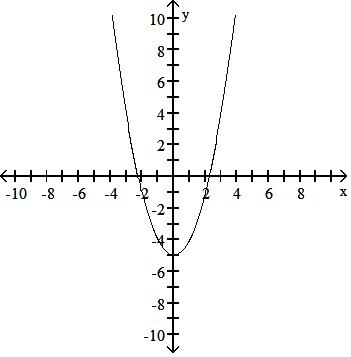

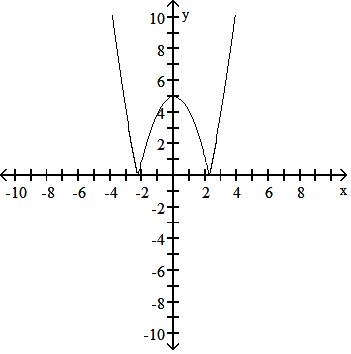
Answer: D

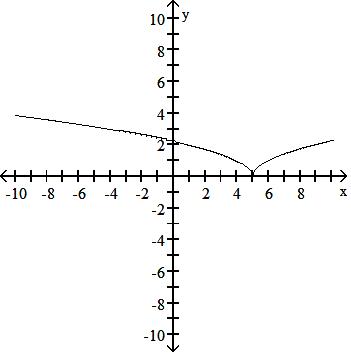
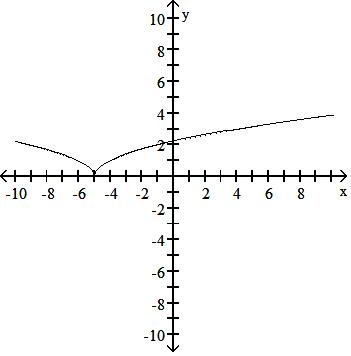
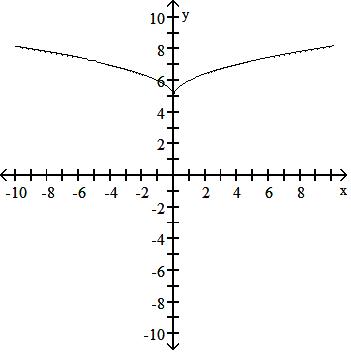

Answer: C
Using the graph below, find the domain and range of the given function, and sketch the graph.
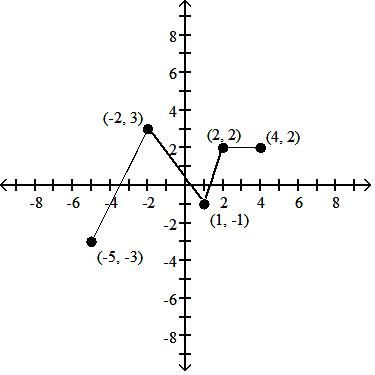

A) D: [-5, 4]; R: [-3, 3]
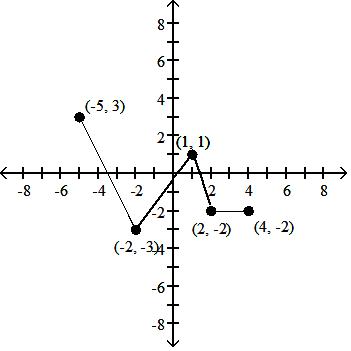

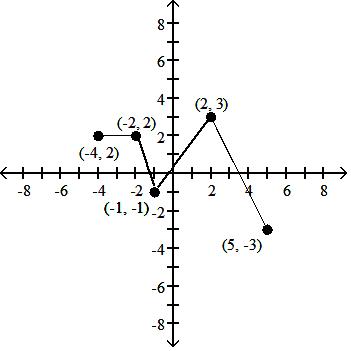
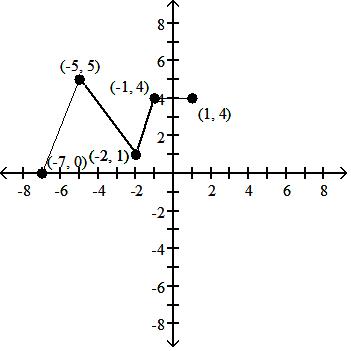
Answer: A

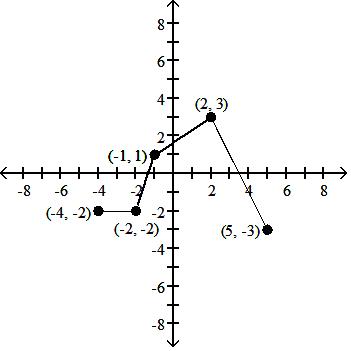
B) D: [-4, 5]; R: [-3, 3]

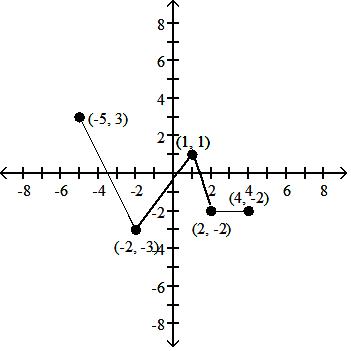
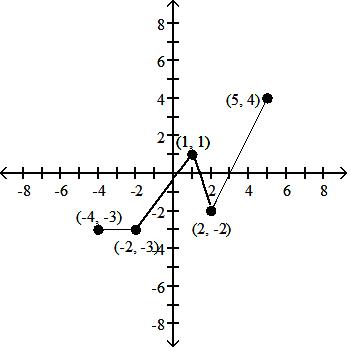
Answer: B


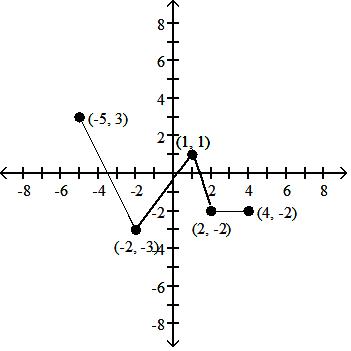
D: [-8, 1]; R: [-2.5, 5]
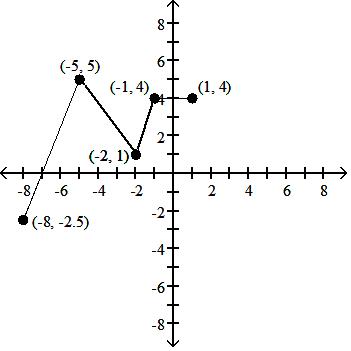

Answer: A
148) y = f(-x - 2) + 1

A) D: [-3, 6]; R: [-2, 4]
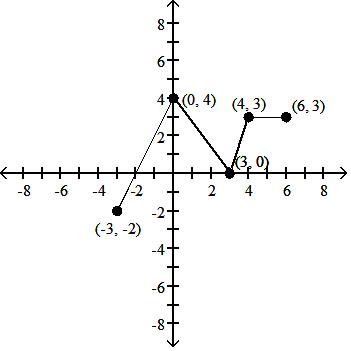

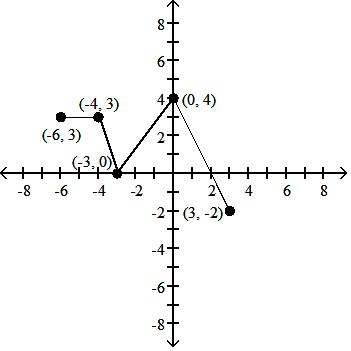
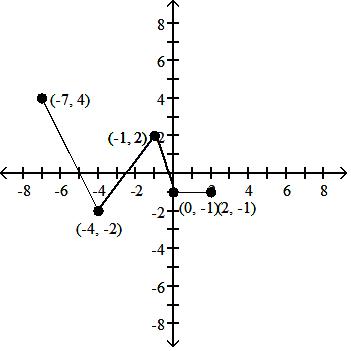
Answer: C
The problem tells by what factor and direction the graph of the given function is to be stretched or compressed. Give an equation for the stretched or compressed graph.
149) y = x2 - 2 stretched horizontally by a factor of 4
A) y = x2 16 - 2
B) y = x2 4 - 2
C) y = 16x2 - 2
D) y = 4x2 - 8
Answer: A
150) y = x2 - 1 compressed vertically by a factor of 2
A) y = 4x2 - 1
B) y = 2x2 - 2
C) y = x2 21 2
D) y = x2 2 - 1
Answer: C
151) y = 1 + 1 x2 stretched vertically by a factor of 7
A) y = 7 + 7 x2
B) y = 1 + 49 x2
C) y = 1 + 7 x2
D) y = 1 7 + 1 7x2
Answer: A
152) y = 1 + 1 x2 compressed horizontally by a factor of 5
A) y = 5 + 5 x2
B) y = 1 + 1 25x2
C) y = 1 5 + 1 5x2
D) y = 1 + 25 x2
Answer: B
153) y = x + 1 compressed vertically by a factor of 3
A) y = x + 1 3
B) y = 3x + 1
C) y = 3 x + 1
D) y = 3x + 3
Answer: A
154) y = x3 + 1 stretched vertically by a factor of 4
A) y = 4x3 + 4
B) y = x3 4 + 1 4
C) y = 64x3 + 1
D) y = 4x3 + 1
Answer: A
Assume that f is an even function, g is an odd function, and both f and g are defined on the entire real line. State whether the combination of functions (where defined) is even or odd.
155) gf
A) Even B) Odd Answer: B
156) g/f
A) Even
B) Odd Answer: B
157) g2
A) Even
B) Odd Answer: A
158) f g
A) Even
B) Odd Answer: A
159) f f
A) Even
B) Odd Answer: A
160) g g
A) Even
B) Odd Answer: B
SHORT ANSWER. Write the word or phrase that best completes each statement or answers the question.
Solve the problem.
161) Graph the functions f(x) = x and g(x) = 2 - x together with their sum, product, two differences, and two quotients.

Answer:

162) Let f(x) = x - 3 and g(x) = x2. Graph f and g together with f g and g f.
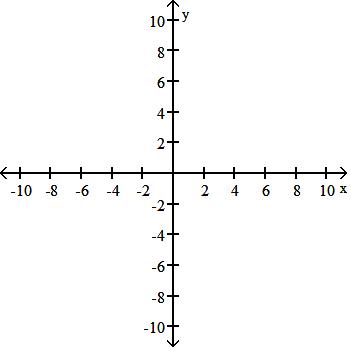
Answer:

MULTIPLE CHOICE. Choose the one alternative that best completes the statement or answers the question.
163) On a circle of radius 12 meters, how long is an arc that subtends a central angle of 5 4 radians?
A) 15 m
B) 60 m
C) 3 m
D) 15 m
Answer: D
164) On a circle of radius 12 meters, how long is an arc that subtends a central angle of 100°?
A) 1,200 m
B) 20 3 m
C) 1,200 m
D) 20 3 m
Answer: D
165) You want to make an angle measuring 45° by marking an arc on the perimeter of a disk with a diameter of 18 inches and drawing lines from the ends of the arc to the disk's center. To the nearest tenth of an inch, how long should the arc be?
A) 14.1 in.
B) 3.5 in.
C) 28.3 in.
D) 7.1 in.
Answer: D
166) If you roll a 1-m-diameter wheel forward 33 centimeters over level ground, through what angle (to the nearest degree) will the wheel turn?
A) 1°
B) 38°
C) 19°
D) 66°
Answer: B
Find the exact value of the trigonometric function. Do not use a calculator or tables.
167) csc 6
2
2
1 2
2 3 3 Answer: A 168) tan 3
3 2
170) sin 3 4
A)
B)
C)2 2
D)1 2
Answer: A
171) cos 7 4
A) B) C) D)2 2
Answer: B
172) tan 5 4
A)
B) 3
C) -1
D)
Answer: A
173) tan2
A) 0
B) 1
C) -1
D) Undefined Answer: D
174) cot ( )
A) -1
B) 1
C) 0
D) Undefined
Answer: D
One of sin x, cos x, and tan x is given. Find the other two if x lies in the specified interval.
175) sin x = 5 13 , x in 2 ,
A) cos x =12 13 , tan x =5 12
B) cos x = 12 13 , tan x =12 5
C) cos x = 12 13 , tan x = 5 12
D) cos x =12 13 , tan x =12 5
Answer: A
176) cos x = 4 5 , x in2 , 0
A) sin x = 3 5 , tan x =4 3
B) sin x =3 5 , tan x =4 3
C) sin x =3 5 , tan x =3 4
D) sin x = 3 5 , tan x = 3 4
Answer: C
177) tan x = 4 3 , x in , 3 2
A) sin x =4 5 , cos x =3 5
B) sin x = 3 5 , cos x = 4 5
C) sin x =3 5 , cos x =4 5
D) sin x = 4 5 , cos x = 3 5
Answer: A
178) sin x =1 3 , x in2 , 0
A) cos x =2 2 3 , tan x =2 4
B) cos x = 2 2 3 , tan x =2 4
C) cos x = 2 2 3 , tan x = 2 4
D) cos x =2 2 3 , tan x = 2 4
Answer: B
179) cos x =1 3 , x in , 3 2
A) sin x = 2 2 3 , tan x = -2 2
B) sin x = 2 2 3 , tan x = 2 2
C) sin x =2 2 3 , tan x = 2 2
D) sin x =2 2 3 , tan x = -2 2
Answer: C
180) tan x =3 4 , x in 2 ,
A) sin x = 4 5 , cos x =3 5
B) sin x = 3 5 , cos x = 4 5
C) sin x = 3 5 , cos x =4 5
D) sin x =3 5 , cos x = 4 5
Answer: C
181) sin x =5 3 , x in2 , 0
A) cos x =2 3 , tan x = 5 2
B) cos x = 2 3 , tan x =5 2
C) cos x =2 3 , tan x =5 2
D) cos x = 2 3 , tan x = 5 2
Answer: B
182) cos x =2 2 , x in3 2 , -
A) sin x =2 2 , tan x = -1
B) sin x = 2 2 , tan x = 1
C) sin x =2 2 , tan x = 1
D) sin x = 2 2 , tan x = -1
Answer: D
183) tan x = 1, x in , 3 2
A) sin x = 2 2 , cos x =2 2
B) sin x =2 2 , cos x = 2 2
C) sin x = 2 2 , cos x = 2 2
D) sin x =2 2 , cos x =2 2
Answer: D
184) sin x =3 2 , x in2 , 0
A) cos x = -2, tan x = 3 3
B) cos x = 1 2 , tan x = 3
C) cos x =1 2 , tan x = - 3
D) cos x = 1 2 , tan x = - 3
Answer: D
State the period of the function and graph. 185) sin 8x

A) Period 4
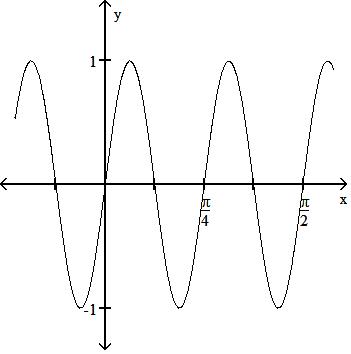
B) Period 4

C) Period 4
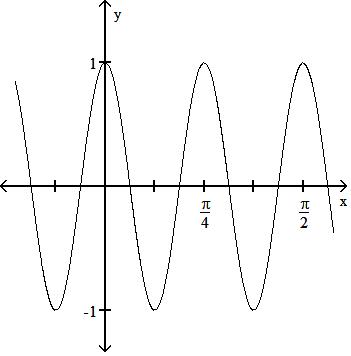
D) Period 4
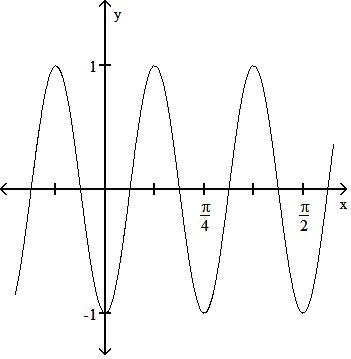
Answer: A
-sin x 2

A) Period 4
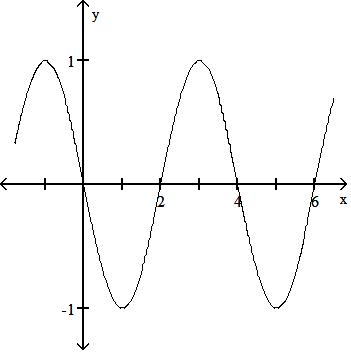
B) Period 4

C) Period 4
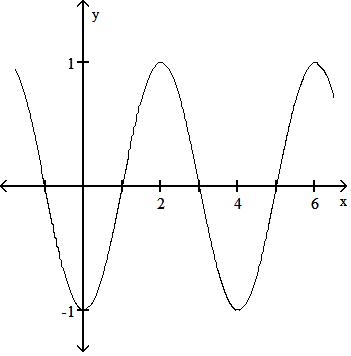
D) Period 4
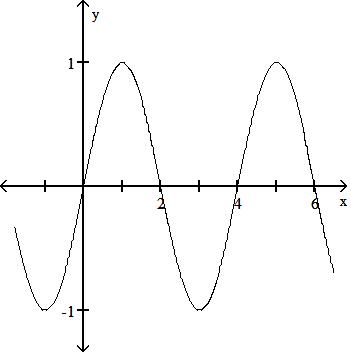
Answer: A
187) sin x4
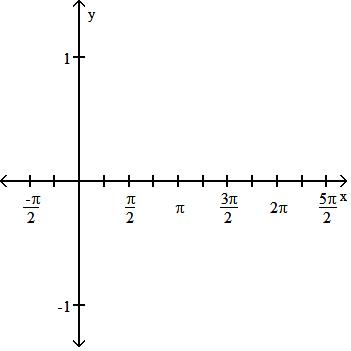
A) Period 2
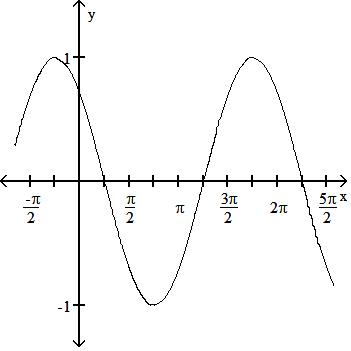
B) Period 2
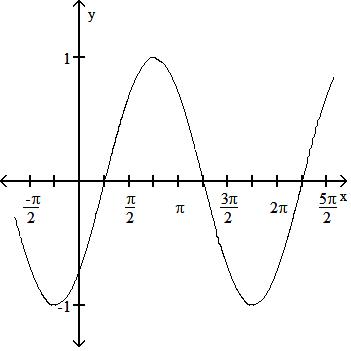
C) Period 2

D) Period 2

Answer: B

A) Period 2

B) Period 2

C) Period 2

D) Period 2

Answer: A

A) Period 2

B) Period 2

C) Period 2

D) Period 2
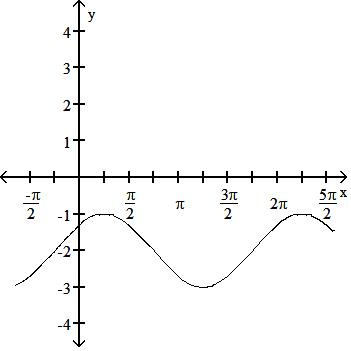
Answer: D
190) cos x4 - 3

A) Period 2

B) Period 2
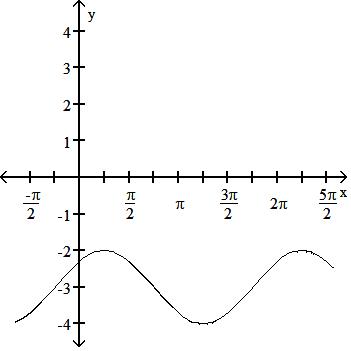
C) Period 2

D) Period 2

Answer: B
Graph the function in the ts-plane (t-axis horizontal, s-axis vertical). State the period and symmetry of the function. 191) s = -tan 2t
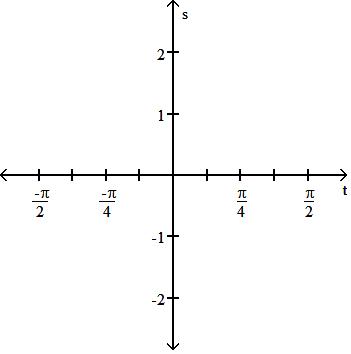
A) Period 2 , symmetric about the origin

B) Period , symmetric about the origin

C) Period 2 , symmetric about the origin
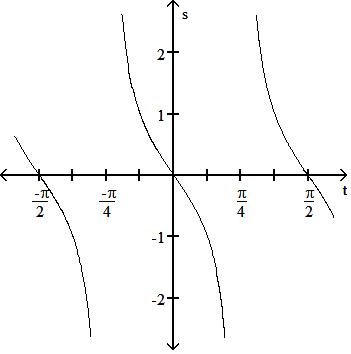
D) Period 2 , symmetric about the s-axis

Answer: C

A) Period 8 , symmetric about the t-axis
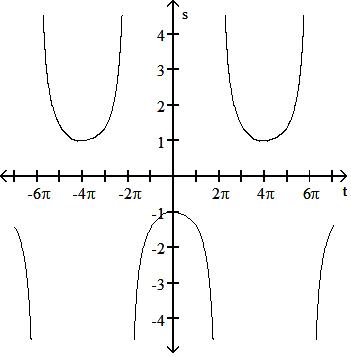
B) Period 8 , symmetric about the t-axis

C) Period 8 , symmetric about the s-axis

D) Period 8 , symmetric about the s-axis

Answer: D
193) s = csc t 4
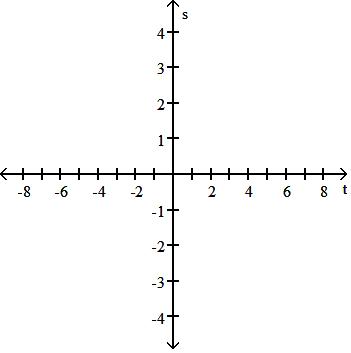
A) Period 8, symmetric about the s-axis
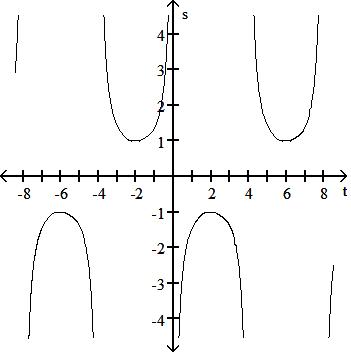
B) Period 8, symmetric about the s-axis
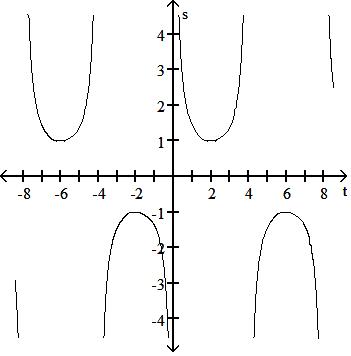
C) Period 8, symmetric about the origin

D) Period 8, symmetric about the origin
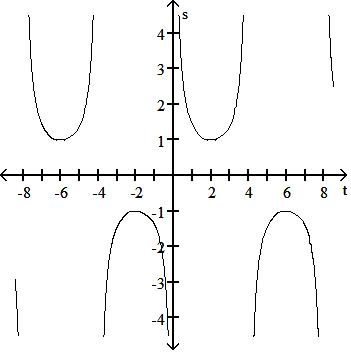
Answer: D
SHORT ANSWER. Write the word or phrase that best completes each statement or answers the question. Use the addition formulas to derive the identity.
194) cos x2 = sin x
Answer: cos x2 = cos x cos2 - sin x sin2
= cos x (0) - sin x (-1)
= 0 + sin x
= sin x
195) cos x + 2 = -sin x
Answer: cos x + 2 = cos x cos 2 - sin x sin 2
= cos x (0) - sin x (1)
= 0 - sin x = -sin x
196) sin x + 2 = cos x
Answer: sin x + 2 = sin x cos 2 + cos x sin 2
= sin x (0) + cos x (1)
= 0 + cos x = cos x
197) sin x2 = -cos x
Answer: sin x2 = sin x cos2 + cos x sin2
= sin x (0) + cos x (-1)
= 0 - cos x = -cos x
MULTIPLE CHOICE. Choose the one alternative that best completes the statement or answers the question.
Express the given quantity in terms of sin x or cos x.
198) cos (6 + x)
A) cos x B) -sin x
C) cos x - sin x D) -cos x Answer: A
199) cos (7 + x)
A) -sin x B) sin x - cos x C) cos x D) -cos x Answer: D
200) sin (5 + x)
A) cos x + sin x B) sin x C) -sin x D) cos x - sin x Answer: C
201) sin (2 + x)
A) sin x B) cos x + sin x C) -sin x D) cos x - sin x Answer: A
202) cos 3 2 + x
A) cos x B) sin x C) -sin x D) cos x + sin x
Answer: B
203) sin 7 2 + x
A) -cos x B) sin x - cos x C) cos x
D) -cos x - sin x
Answer: A
204) sin (4 - x)
A) sin x B) -sin x C) cos x - sin x D) sin (-x)
Answer: B
205) cos (2 - x)
A) cos x - sin x B) -cos x C) cos x D) cos x + sin x
Answer: C
206) sin 7 2 - x
A) cos x B) -cos x - sin x
C) -cos x D) -cos (-x)
Answer: C
207) cos 3 2 - x
A) sin (-x)
B) cos x + sin x C) sin x D) -sin x
Answer: D
Use the appropriate addition formula to find the exact value of the expression.
208) sin 11 12
A)6 + 2 4
B) 6 - 2 4
C) 6 + 2 4
D) 2 - 6 4
Answer: B
209) sin11 12
A)6 + 2 4
B) 6 + 2 4 C) 6 - 2 4 D) 2 - 6 4
Answer: D
210) cos 12 A) 6 - 2 4
B)6 + 2 4 C) 2 - 6 4 D) 6 + 2 4
Answer: D
211) cos7 12
A) 2 - 6
B) 2 - 6 4
C) 6 - 2 4
D) 6 + 2
Answer: B
212) tan 7 12
A) 2 + 3 4
B) 2 + 3
C) 2 - 3 4
D) -2 - 3
Answer: D
213) tan7 12
A) 2 - 3 4
B) -2 - 3
C) 2 + 3 4
D) 2 + 3
Answer: D
214) tan 13 12
A) 2 + 3 4
B) 2 - 3
C) 2 + 3
D) 2 - 3 4
Answer: B
215) sin 17 12 A) 6 + 2 4 B)6 + 2 4 C) 2 - 6 4 D) 6 - 2 4
Answer: B 216) cos 19 12 A) 2 - 6 4 B) - 6 - 2 C) 2 - 6
6 - 2 4
Answer: D 217) sin 19 12 A) 2 - 6 4 B) 6 + 2 4 C)6 + 2 4 D) 6 - 2 4
Answer: C Find the function value. 218) cos2 12
Answer: C
219) cos2 6
A) 1 4
B) 2 + 3 4
C) 3 4
D) 2 + 3
Answer: C
Solve for the angle , where 0 2
220) sin2 = 1 4
A) = 4 , 4 , 4 , 4
B) = 6 , 6 , 6 , 11 6
C) = 3 , 3 , 3 , 3
D) = 0, , 2
Answer: B
221) sin2 = 3 4
A) = 4 , 4 , 4 , 4
B) = 3 , 3 , 3 , 3
C) = 0, , 2
D) = 6 , 6 , 6 , 11 6
Answer: B
222) cos2 = 1 4
A) = 4 , 4 , 4 , 4
B) = 6 , 6 , 6 , 11 6
C) = 3 , 3 , 3 , 3
D) = 0, , 2
Answer: C
223) cos2 = 3 4
A) = 0, , 2
B) = 6 , 6 , 6 , 11 6
C) = 3 , 3 , 3 , 3
D) = 4 , 4 , 4 , 4
Answer: B
224) sin 2 - cos = 0
A) 0, 2 , , 2 , 2
B) 4 , 4 , 6 , 11 6
C) = 2 , 2 , 6 , 6
D) = 6 , 6 , 6 , 11 6
Answer: C
225) sin 2 + cos = 0
A) = 6 , 6 , 6 , 11 6
B) = 2 , 2 , 6 , 11 6
C) 4 , 4 , 6 , 11 6
D) = 2 , 2 , 6 , 6
Answer: B
Find the requested information using the law of cosines and/or the law of sines. Round to three decimal places. 226) A triangle has sides a = 4 and b = 5 and angle C = 40°. Find the length of side c.
A) 3.218
B) 5.067
C) 10.358
D) 3.91
Answer: A
227) A triangle has sides a = 4 and b = 3 and angle C = 60°. Find the sine of B.
A) 0.08
B) 0.72
C) 0.961
D) 0.24
Answer: B
228) A triangle has side c = 5 and angles A = 3 and B = 4 Find the length b of the side opposite B.
A) 0.146
B) 0.732
C) 4.483
D) 3.66
Answer: D
For
f(x) = A sin 2 B (x - C) + D, identify either A, B, C, or D as indicated for the sine function.
229) y = -2 sin - 2 Find A.
A)
B) -4
C) - 2
D)
Answer: C
230) y= 1 2 sin + 2 Find B.
A) 2
B) 2
C) 2
D) 1
Answer: C
231) y = -2 sin - + 2 Find C.
A) B)8 C) 8
D)
Answer: D
232) y = -21 2 sin 1 2 - Find D.
A) B)
C) 1
D) -2
Answer: D
233) y = 3 cos 2x + 4 Find A.
A) 6
B) 2
C) 2
D) 3
Answer: D
234) y = -4 sin 2x + 2 Find A.
A) 2
B) -4
C) 2
D) -8
Answer: B
235) y = -4 sin 8x + 2 Find B.
A) 4
B) 8
C) 4
D)
Answer: A
236) y = -4 cos 3x + 2 Find B.
A) 4
B) 2 3
C) 2
D)
Answer: B
SHORT ANSWER. Write the word or phrase that best completes each statement or answers the question. Solve the problem.
237) Use the angle sum formulas to derive sin (A - B) = sin A cos B - cos A sin B.
Answer: sin (A - B) = sin (A + (-B)) = sin A cos (-B) + cos A sin (-B) = sin A cos B - cos A sin B
238) The standard formula for the tangent of the difference of two angles is tan (A - B) = tan A - tan B 1 + tan A tan B Derive the formula.
Answer: tan (A - B) = sin (A - B) cos (A - B) = sin A cos B - sin B cos A cos A cos B + sin A sin B = (cos A cos B)-1(sin A cos B - sin B cos A) (cos A cos B)-1(cos A cos B + sin A sin B) = tan A - tan B 1 + tan A tan B
239) Graph y = cos 2x and y = sec 2x together for3 4 x 3 4 . Comment on the behavior of sec 2x in relation to the signs and values of cos 2x.
Answer: When y = cos 2x is at a maximum point, which is at any multiple of , y = sec 2x is a minimum point. Similarly, when cos (2x) is at a minimum point, which is at any odd multiple of 2 , y = sec 2x is a at maximum point.
240) Graph y = sin x 2 and y = csc x 2 together for -2 x 2 . Comment on the behavior of csc x 2 in relation to the signs and values of sin x 2
Answer: When y = sin x 2 is at a maximum point, which is at x = (4n + 1) for all integers n, y = csc x 2 is at a minimum point. Similarly, when y = sin x 2 is at minimum point, , which is at x = (4n - 1) for all integers n, y = csc x 2 is at a maximum point.
241) What happens if you set B = -2 in the angle sum formulas for the sine and cosine functions? Do the results agree with something you already know?
Answer: If B = -2 , then cos (A + B) = cos A and sin (A + B) = sin A. Because the period of both of the sine and cosine functions is 2 , if B is replaced by a multiple of 2 the angle sum formulas must produce the same value as the sine or cosine function.
MULTIPLE CHOICE. Choose the one alternative that best completes the statement or answers the question.
Use a graphing calculator or computer to determine which of the given viewing windows displays the most appropriate graph of the specified function.
242) f(x) = x4 - 8x2 + 2x
A) [-5, 5] by [-10, 15]
B) [-10, 15] by [-5, 5]
C) [-25, 15] by [-5, 5]
D) [-5, 5] by [-25, 15]
Answer: D
243) f(x) = x3 - 2x2 - 3x + 15
A) [-5, 5] by [-5, 25]
B) [-20, 20] by [-100, 100]
C) [-5, 25] by [-5, 5]
D) [-2, 2] by [-10, 10]
Answer: A
244) f(x) = 12 + 5x - x3
A) [-10, 20] by [-50, 50]
B) [-10, 10] by [-10, 5]
C) [-4, 5] by [-5, 5]
D) [-4, 5] by [-15, 25]
Answer: D
245) f(x) = 7 + 6x - x2
A) [-4, 5] by [-15, 25]
B) [-4, 5] by [-5, 5]
C) [-10, 20] by [-50, 50]
D) [-10, 10] by [-10, 5]
Answer: A
246) f(x) = x2/3(6 - x)
A) [-4, 9] by [-10, 10]
B) [-4, 0] by [-5, 5]
C) [-2, 2] by [-15, 15]
D) [0, 9] by [-10, 10]
Answer: A
247) f(x) = |x2 - 6|
A) [-10, 10] by [-15, 15]
B) [-5, 5] by [-15, 15]
C) [-5, 5] by [-2, 10]
D) [0, 5] by [-2, 10]
Answer: C
248) f(x) = x2 - 1 x2 + 1
A) [-10, 10] by [-10, 10]
B) [-10, 10] by [-2, 2]
C) [-1, 1] by [-2, 2]
D) [-5, 5] by [-15, 15]
Answer: B
249) f(x) = 10 x2 - 8
A) [-2, 2] by [-10, 10]
B) [-5, 5] by [-10, 10]
C) [0, 5] by [-10, 10]
D) [-5, 0] by [-10, 10]
Answer: B
250) f(x) = 2 cos 70x
A) [-1, 1] by [-4, 4]
B) [-10, 10] by [-10, 10]
C) [-0.2, 0.2] by [-4, 4]
D) [-0.2, 0.2] by [-1, 1]
Answer: C
251) f(x) = x2 + 1 20 cos 50x
A) [-0.1, 0.1] by [-0.1, 0.1]
B) [-2, 2] by [-1, 1]
C) [-10, 10] by [-10, 10]
D) [-0.6, 0.6] by [-0.1, 0.6]
Answer: D
Determine an appropriate viewing window for the given function and use it to display its graph.
252) f(x) = -0.7x6 - x5 + 5x4 - 3x3 - 5x2 + x - 3
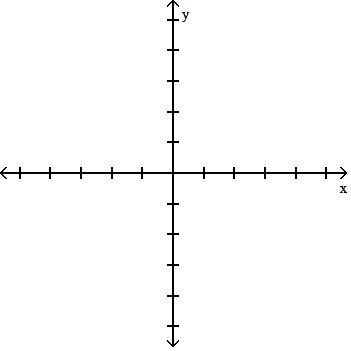
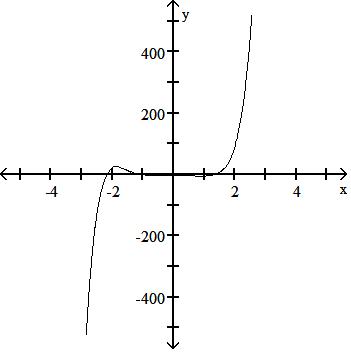
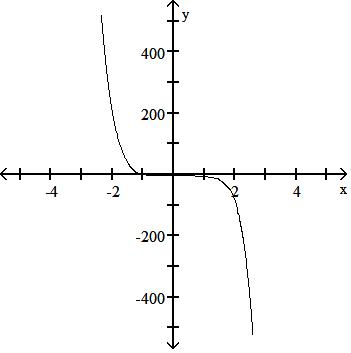


Answer: D
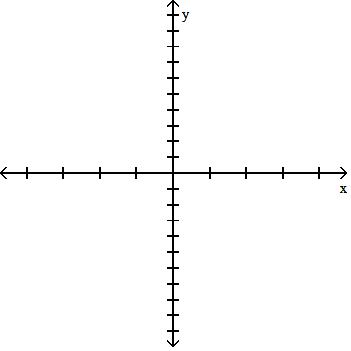


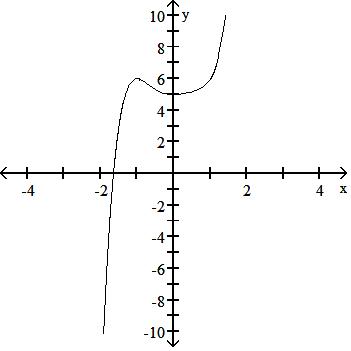
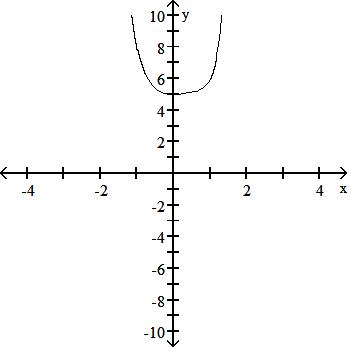
Answer: C


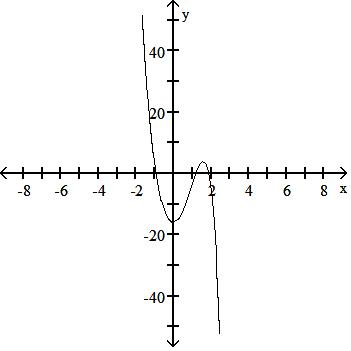
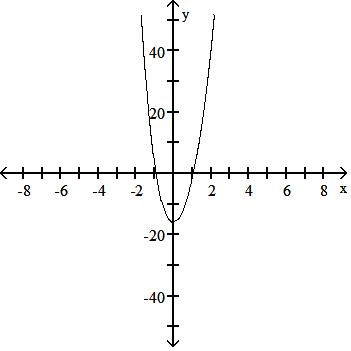
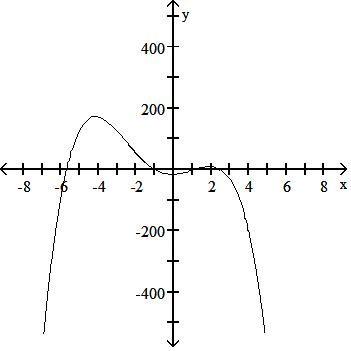
Answer: C

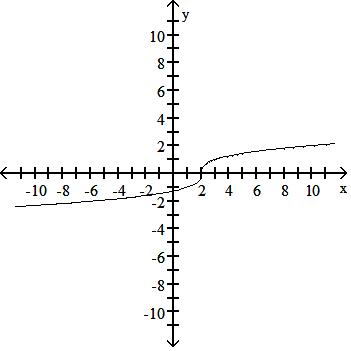

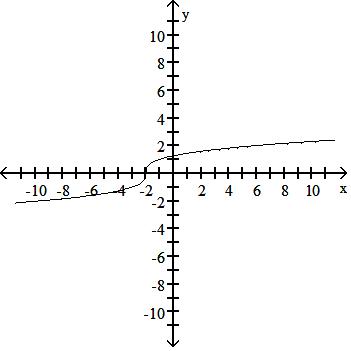
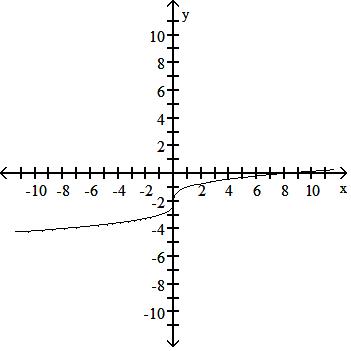
Answer: A
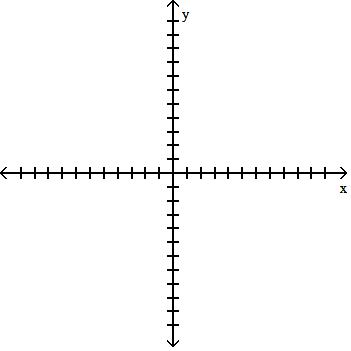

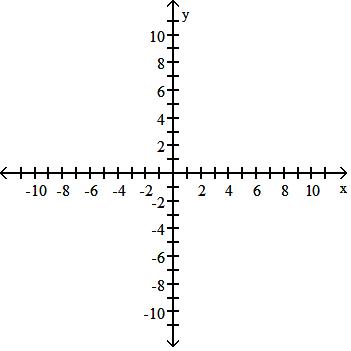


Answer: B
257) f(x) = 6x x2 - 1


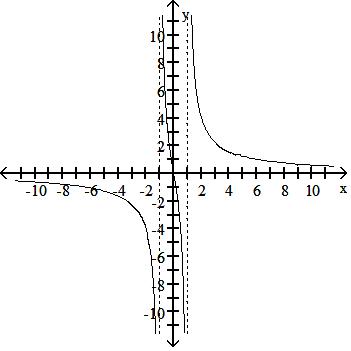
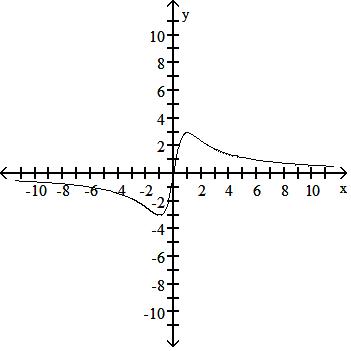

Answer: B

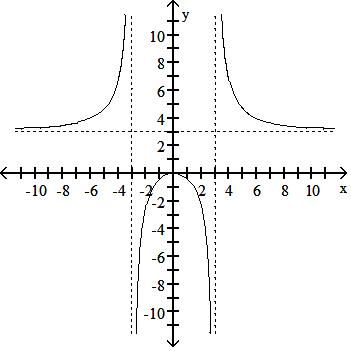
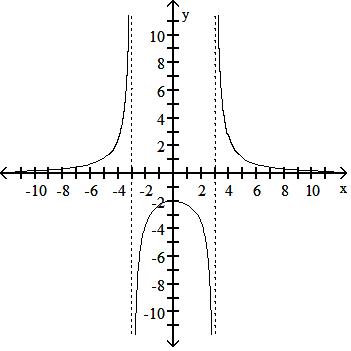

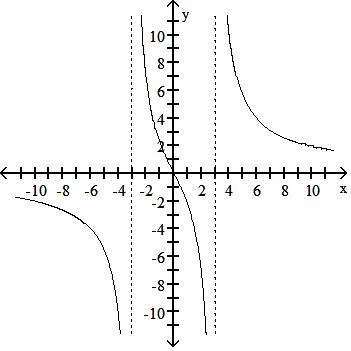
Answer: A

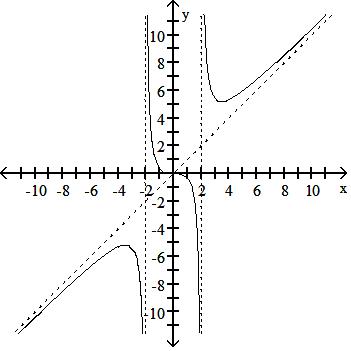



Answer: A
260) f(x) = x3 x2 + 4

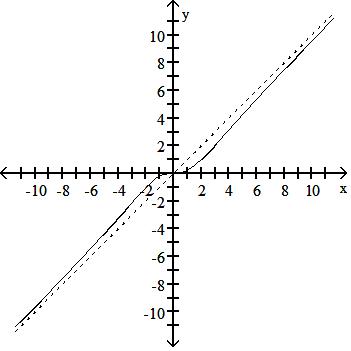



Answer: A


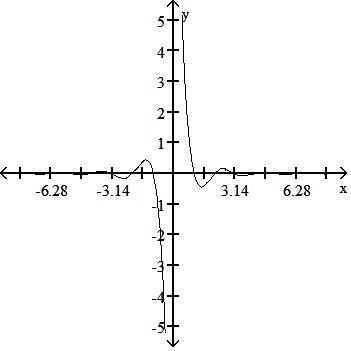

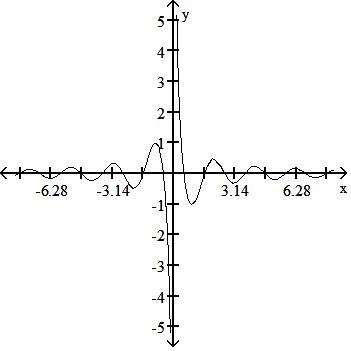
Answer: C
Graph the function.
262) Graph the upper half of the circle defined by the equation x2 + y2 - 4x - 6y + 9 = 0.





Answer: A
263) Graph the lower branch of the hyperbola y2 - 4x2 = 1.
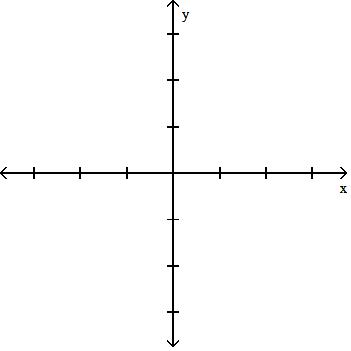

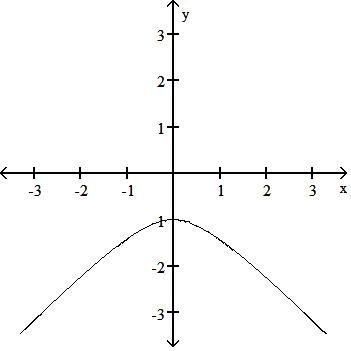


Answer: A
264) Graph five periods of the function f(x) = tan 4x.
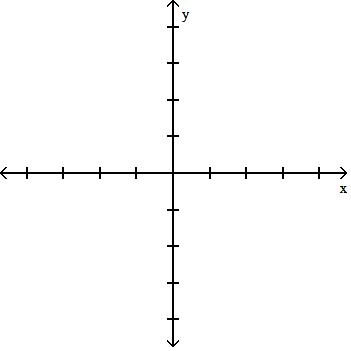

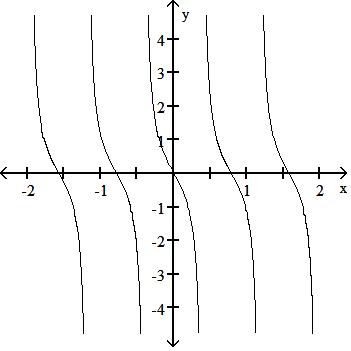


Answer: D
265) Graph two periods of the function f(x) = -cot x 2 + 1.


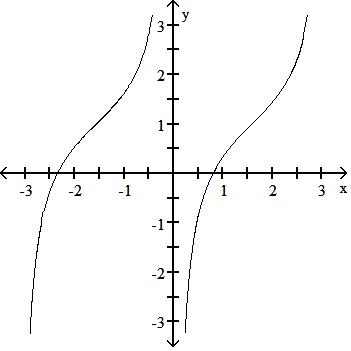


Answer: A
Graph the function f(x) = sin 4x + cos 2x.

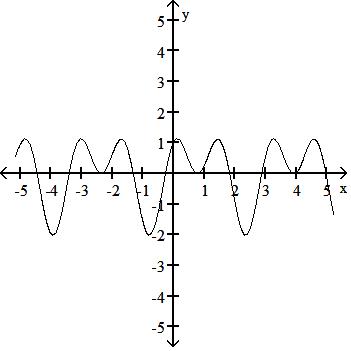

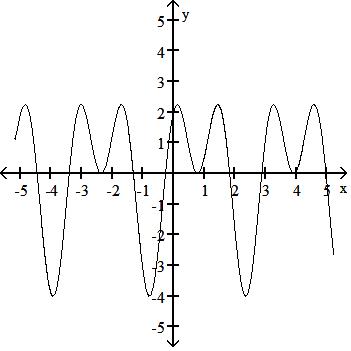

Answer: D
267) Graph the function f(x) = 2 cos3 x.



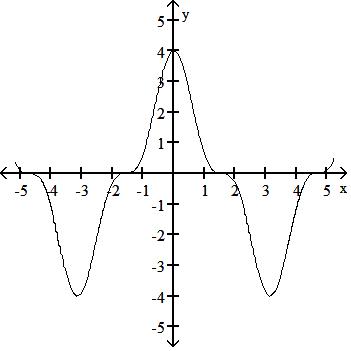
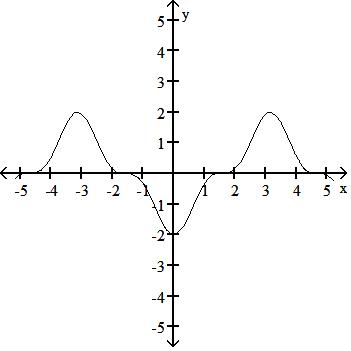
Answer: A
Solve the problem.
268) The table shows the average weight for women of medium frame based on height. Find a regression line for the data.
A) y = 3.9941x - 68.5636
B) y = 3.8428x - 73.7191
C) y = 3.2848x - 78.5727
D) y = 4.5781x - 52.6742
Answer: C
269) The table shows the amount of yeast cells (measured as biomass) growing over a 7-hour period in a nutrient. (a) Find a regression quadratic for the data. (b) Use the regression quadratic to predict the biomass of yeast in the nutrient after 10 hours. Hour 0 1 2 3 4 5 6 7
A) (a) y = 5.4215x2 - 7.1512x + 15.768 (b) 486.406
B) (a) y = 5.7661x2 - 8.1557x + 13.284 (b) 508.337
C) (a) y = 5.9631x2 - 7.1512x + 13.925 (b) 538.723
D) (a) y = 4.5432x2 + 6.8417x + 19.925 (b) 542.662
Answer: C
Graph the function.
= 3x




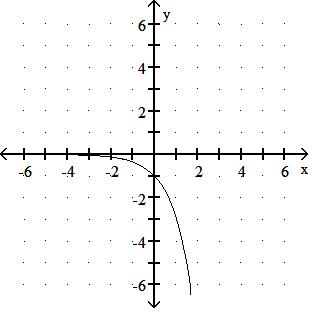
Answer: A


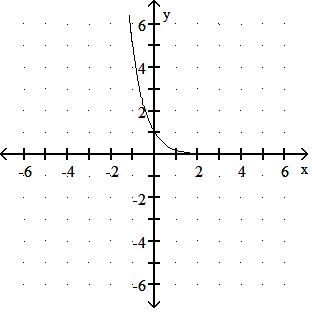
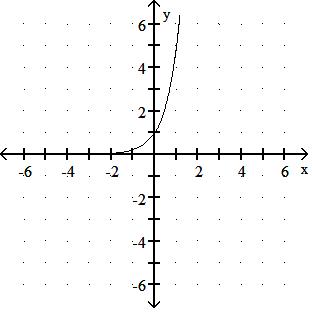
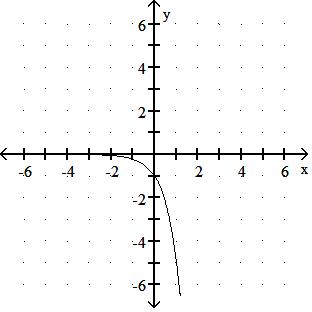
Answer: B





Answer: C

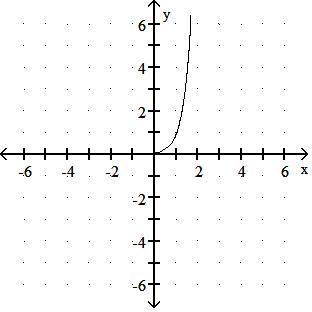

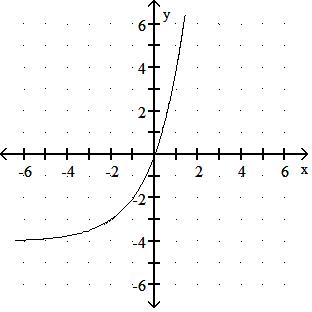

Answer: A




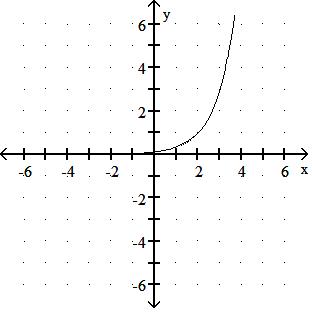
Answer: D
f(x) = 1 5 x + 1





Answer: B
276) f(x) = 1.5x - 2
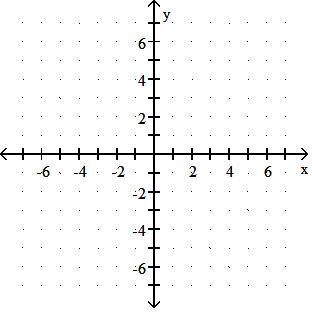
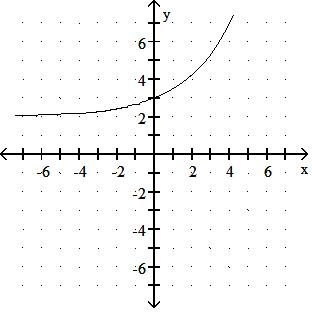

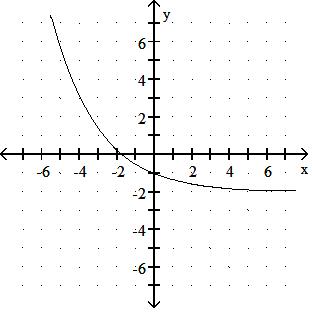
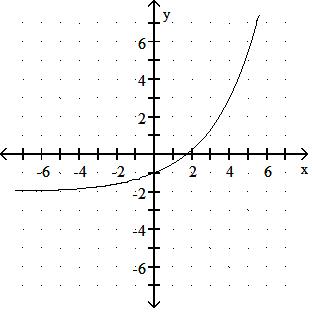
Answer: D

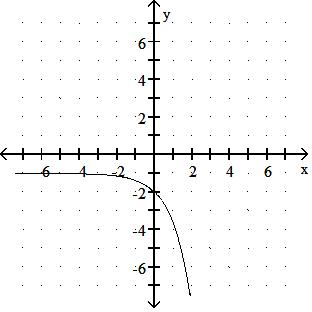
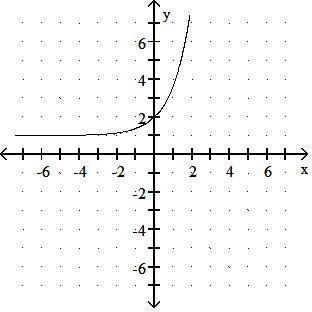

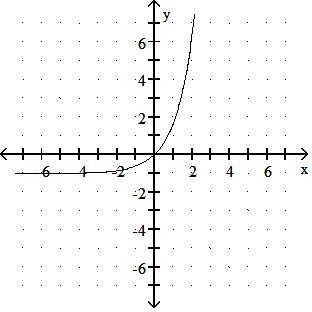
Answer: D

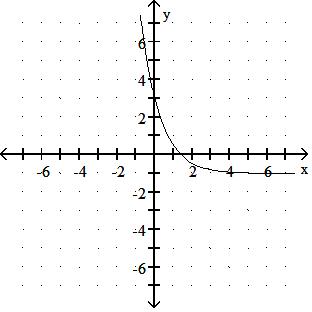
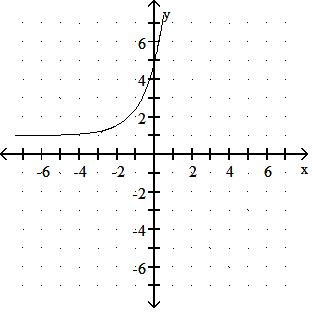
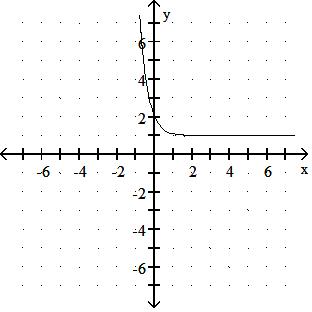
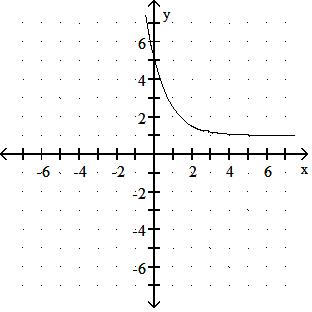
Answer: D

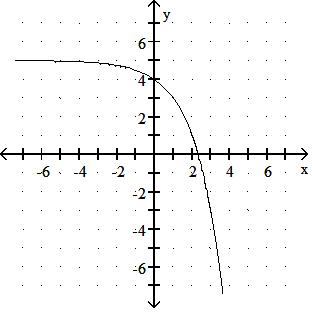
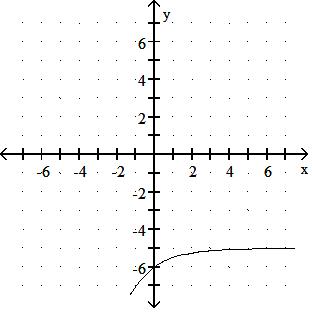

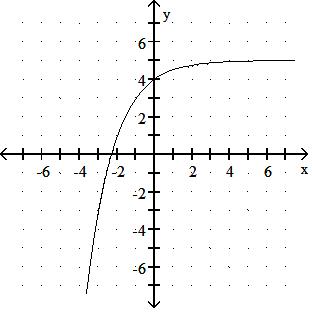
Answer: D
Use the laws of exponents to simplify. Do not use negative exponents in your answer.
280) 38 37
A) 356
B) 956
C) 615
D) 315
Answer: D
281) 4-5 · 49
A) 44
B) 164
C) 4-45
D) 1645
Answer: A
282) 72/3 71/5
A) 4913/15
B) 72/15
C) 713/15
D) 492/15
Answer: C
283) 22 · 2 · 2-9
A) 26
B)1 27
C) 1 26
D) -27
Answer: C
284) 7-2 75
A) 1 77
B) 77
C) 73
D) 1 73
Answer: A
285) 1111/13 11-4/13
A) 1115/13
B) 11-44/169
C) 117/13
D) 1111/13 - 114/13
Answer: A
286) 163 43
A) 1 43
B) 46
C) 43
D) 4
Answer: C
287) 327 2-3
87
A) 27
B) 1
C) 211
D) 411
Answer: C
288) (2-7)-3
A) 210
B) 1 221
C) 1 210
D) 221
Answer: D
289) 8 2562
A) 1,024
B) 5
C) 4
D) 4 256
Answer: C
State the domain and range of the function.
290) f(x) = -3x + 3
A) domain: [0, ); range: (, )
B) domain: (, 0) (0, ); range: (, )
C) domain: (, ); range: (, ]
D) domain: (, ); range: (, )
Answer: D
291) f(x) = 2x - 3
A) domain: (, ); range: [-3, )
B) domain: (, ); range: (, )
C) domain: (, ); range: (-3, )
D) domain: (, 0) (0, ); range: (-3, )
Answer: C
292) f(x) = ex - 1
A) domain: (- , 0) (0, ); range: (-1, )
B) domain: (, ); range: [-1, )
C) domain: (, ); range: (, )
D) domain: (, ); range: (-1, )
Answer: D
293) f(x) = -5-x + 3
A) domain: (, ) (, ); range: (, )
B) domain: (, ); range: (, -5)
C) domain: (, ); range: (, )
D) domain: (, ); range: (, )
Answer: C
294) f(x) = 4-x - 1
A) domain: (, ); range: (, -1]
B) domain: (, ); range: (, -1)
C) domain: (, ); range: (-1, )
D) domain: (, ) (, ); range: (, -1)
Answer: C
295) f(x) = e-x - 2
A) domain: (, ); range: (, -2)
B) domain: (, ); range: (, )
C) domain: (, ); range: (-2, )
D) domain: (, ); range: (, ]
Answer: C
296) f(x) = 6e-x + 1
A) domain: (, ); range: (, )
B) domain: (, ); range: (, 7]
C) domain: (- , 0) ; range: (, )
D) domain: (, ); range: ( , )
Answer: D
297) f(x) = -3e-x + 4
A) domain: (, ); range: (, )
B) domain: (, ); range: (, ]
C) domain: (, ); range: (, )
D) domain: (, ) (, ); range: (, )
Answer: C
298) f(x) = 8 6 + ex
A) domain: (, ); range: 0, 4 3
B) domain: (0, ); range: (0, )
C) domain: (, ); range: (0, 6)
D) domain: (, ); range: (, )
Answer: A
299) f(x) = 4 + 4-x
A) domain: (0, ); range: (, )
B) domain: (, ); range: (0, 2)
C) domain: (, ); range: (, )
D) domain: (, ); range: (2, )
Answer: D
Use a graph to find an approximate solution to the equation. Round to the nearest thousandth.
300) 5x = 14
A) 0.610
B) 2.800
C) 1.030
D) 1.640
Answer: D
301) 4(x - 1) = 14
A) 2.904
B) 2.253
C) 0.904
D) 4.500
Answer: A
302) 5(5x - 1) = 11
A) 0.098
B) 0.358
C) 0.498
D) 0.640 Answer: C
303) 5e3x + 4 = 15
A) 1.700
B) 3.667
C) -0.967
D) -1.153
Answer: C
304) 6x + 5 = 2x
A)
B) -9.865
C) -8.155
D) -6.445
Answer: C
305) 183 - x = 30
A) -1.333
B) 1.823
C) D) 3.850 Answer: B
306) 43x = 7x + 1
A) -3.477
B) 1.404
C) 0.879
D) 2.404
Answer: C
307) 3e5x+9 = 8
A) -3.034
B) -0.174
C) -3.426
D) -1.604
Answer: D
308) e8xe2x = e4
A) 0.400
B) -0.640
C) 0.504
D) 1.440
Answer: A
309) 181(1.37)x/9 = 362
A) 18.406
B) 4.088
C) 21.226
D) 19.816
Answer: D
Solve the problem.
310) In the formula N = Iekt, N is the number of items in terms of an initial population I at a given time t and k is a growth constant equal to the percent of growth per unit time. How long will it take for the population of a certain country to double if its annual growth rate is 2.5%? Round to the nearest year.
A) 80 yr
B) 1 yr
C) 28 yr
D) 12 yr
Answer: C
311) In the formula N = Iekt, N is the number of items in terms of an initial population I at a given time t and k is a growth constant equal to the percent of growth per unit time. How long will it take for the population of a certain country to triple if its annual growth rate is 7.1%? Round to the nearest year.
A) 7 yr
B) 42 yr
C) 15 yr
D) 1 yr
Answer: C
312) In the formula N = Iekt, N is the number of items in terms of an initial population I at a given time t and k is a growth constant equal to the percent of growth per unit time. There are currently 53 million cars in a certain country, increasing by 5.2% annually. How many years will it take for this country to have 80 million cars? Round to the nearest year.
A) 5 yr
B) 3 yr
C) 63 yr
D) 8 yr
Answer: D
313) The number of acres in a landfill decreases according to the function B = 3,000e-0.05t, where t is measured in years. How many acres will the landfill have after 9 years?
A) 2,396 acres
B) 1,913 acres
C) 1,040 acres
D) 1,064 acres
Answer: B
314) A bacteria colony doubles in 7 hr. How long does it take the colony to triple? Use N = N0 2t/T, where N0 is the initial number of bacteria and T is the time in hours it takes the colony to double. (Round to the nearest hundredth, as necessary.)
A) 11.09 hr
B) 21 hr
C) 2.84 hr
D) 10.5 hr
Answer: A
315) The population of a small country increases according to the function B = 1,900,000e0.05t, where t is measured in years. How many people will the country have after 7 years?
A) 4,253,570 people
B) 1,994,662 people
C) 866,271 people
D) 2,696,228 people
Answer: D
316) Use the formula P = Iekt, where P is the resulting population, I is the initial population, and t is measured in hours. A bacterial culture has an initial population of 10,000. If its population declines to 4,000 in 6 hours, what will it be at the end of 8 hours?
A) 1,474
B) 2,530
C) 3,000
D) 2,947
Answer: D
317) The amount of particulate matter left in solution during a filtering process decreases by the equation P = 800(2)-0.6n , where n is the number of filtering steps. Find the amounts left for n = 0 and n = 5. (Round to the nearest whole number.)
A) 1,600, 100
B) 800, 100
C) 800, 6,400
D) 800, 25
Answer: B
318) The decay of 407 mg of an isotope is given by A(t)= 407e-0.017t, where t is time in years. Find the amount left after 87 years.
A) 47 mg
B) 400 mg
C) 93 mg
D) 91 mg
Answer: C
319) Find the amount of interest earned on the following deposit: $1,000 at 11% compounded annually for 12 years
A) $2,883.28
B) $2,151.76
C) $2,498.45
D) $3,498.45
Answer: C
320) Find the amount of interest earned on the following deposit: $1,000 at 10% compounded annually for 12 years
A) $2,452.27
B) $1,853.12
C) $3,138.43
D) $2,138.43
Answer: D
321) Find the amount of interest earned on the following deposit: $1,000 at 8% compounded annually for 12 years
A) $1,719.62
B) $1,331.64
C) $1,518.17
D) $2,518.17
Answer: C
322) Suppose the consumption of electricity grows at 7.2% per year, compounded continuously. Find the number of years before the use of electricity has tripled. Round the answer to the nearest hundredth.
A) 41.67 yr
B) 0.15 yr
C) 1.53 yr
D) 15.26 yr
Answer: D
323) An economist predicts that the buying power B(x) of a dollar x years from now will decrease according to the formula B(x) = 0.21x. How much will today's dollar be worth in 2 years? Round the answer to the nearest cent.
A) $0.04
B) $1.16
C) $0.73
D) $0.42
Answer: A
324) The purchasing power of a dollar is decreasing at the rate of 7.3% annually, compounded continuously. How long will it take for the purchasing power of $1.00 to be worth $0.34? Round answers to the nearest hundredth.
A) 14.78 yr
B) 1.48 yr
C) 4.66 yr
D) 0.15 yr
Answer: A
Is the function graphed below one-to-one?
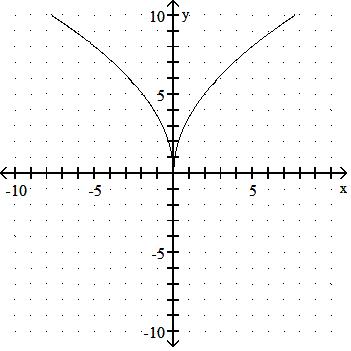
A) Yes
B) No Answer: B

A) No
B) Yes Answer: B
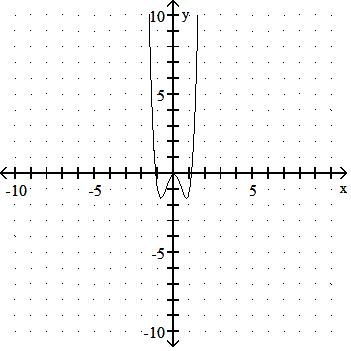
A) Yes
B) No
Answer: B
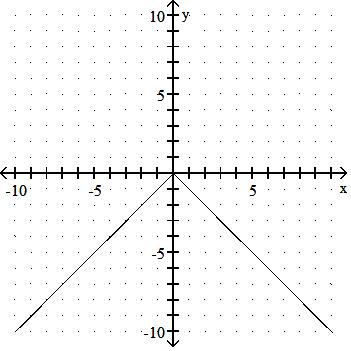
A) Yes
B) No
Answer: B
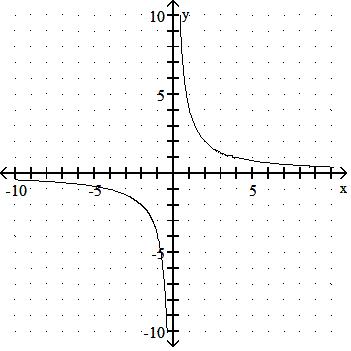
A) No
B) Yes
Answer: B
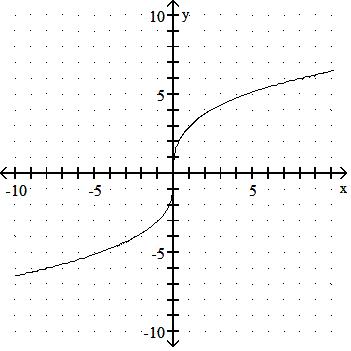
A) No
B) Yes
Answer: B
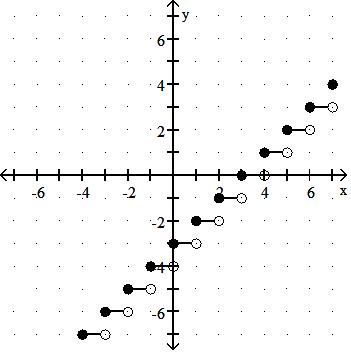
A) Yes
B) No
Answer: B
Determine from its graph if the function is one-to-one.
332) f(x) = -x - 3, x < 1 1, x 1
A) Yes
B) No Answer: B
333) f(x) = x - 1, x > 0 -5, x 0
A) Yes
B) No
Answer: B
334) f(x) = -1 - x, x 2 1 - 2x, x > 2
A) Yes
B) No
Answer: A
335) f(x) = 1 + x 6 , x 0 x x - 6 , x < 0
A) Yes
B) No
Answer: A
336) f(x) = 5x + 8, x < 0 2x2 - 5, x 0
A) Yes
B) No Answer: B
Graph the inverse of the function plotted, on the same set of axes. Use a dashed curve for the inverse. 337)

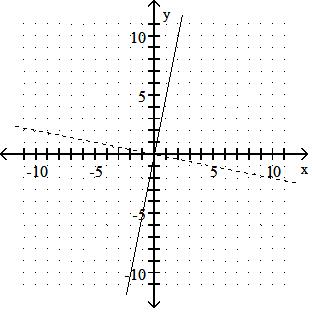



Answer: B



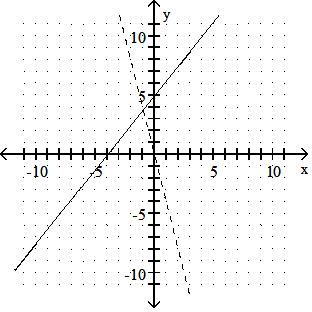
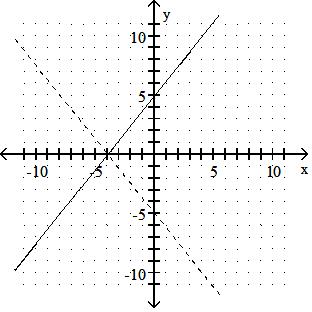
Answer: A


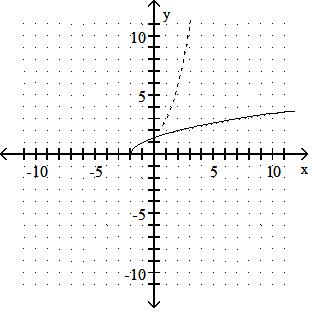

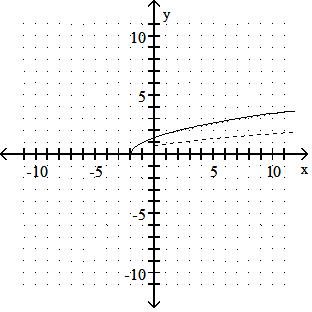
Answer: C

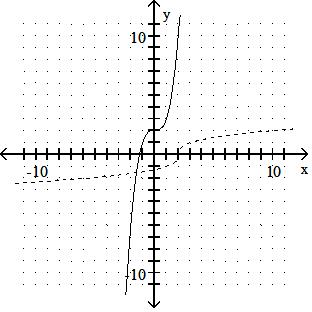
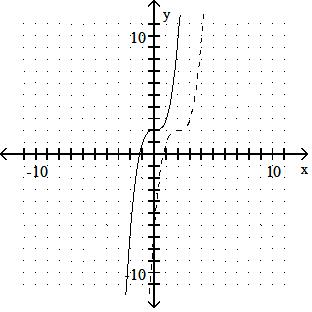
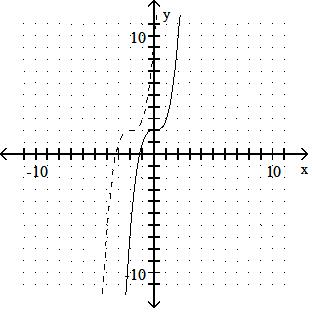
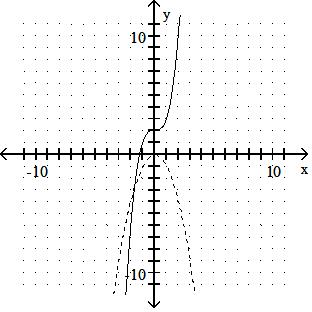
Answer: A
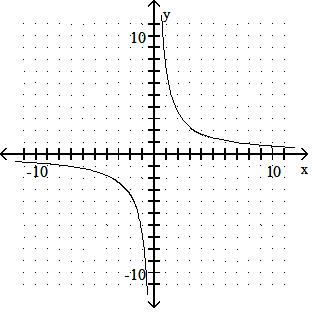
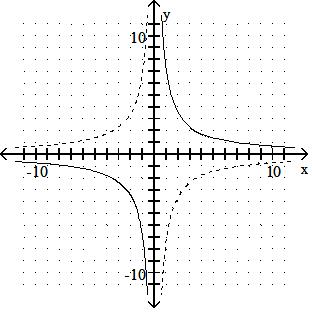


D) Function is its own inverse.

Answer: D
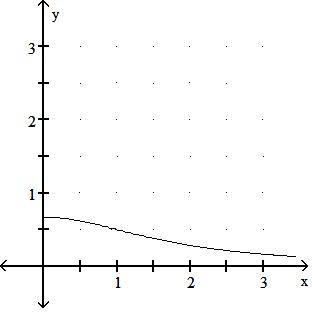
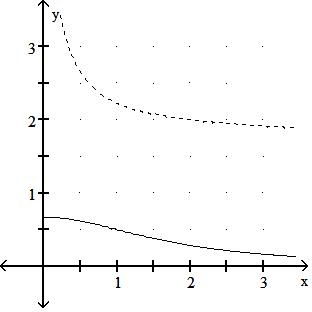



Answer: B
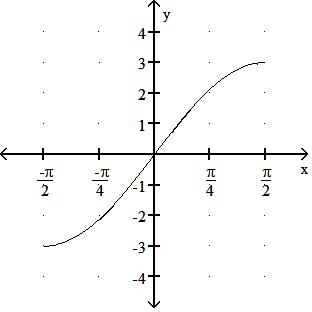
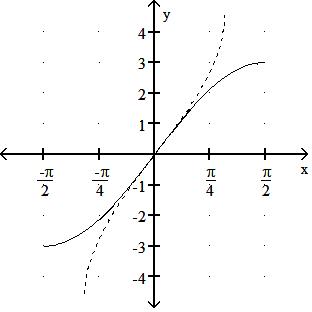

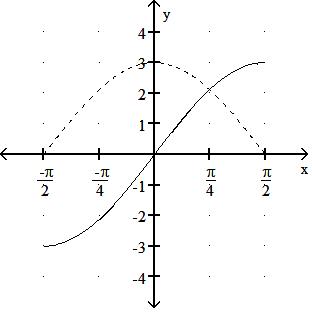
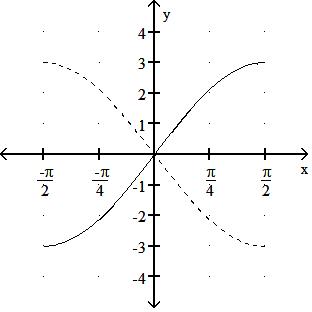
Answer: B
Find the inverse of the function.
344) f(x) = 5x + 1
A) f-1(x) = x + 1 5
B) f-1(x) = x 5 - 1
C) f-1(x) = x - 1 5
D) Not a one-to-one function
Answer: C
345) f(x) = x3 + 7
A) f-1(x) = 3 x - 7
B) f-1(x) = 3 x - 7
C) f-1(x) = 3 x + 7
D) Not a one-to-one function
Answer: A
346) f(x) = 5x3 - 4
A) f-1(x) = 3 x - 4 5
B) Not a one-to-one function
C) f-1(x) = 3 x 5 + 4
D) f-1(x) = 3 x + 4 5
Answer: D
347) f(x) = x + 6, x -6
A) Not a one-to-one function
B) f-1(x) = -x2 + 6, x 0
C) f-1(x) = x2 - 36, x 0
D) f-1(x) = x2 - 6, x 0
Answer: D
348) f(x) = x - 7, x 0
A) f-1(x) = x + 7, x 7
B) f-1(x) = (x - 7)2
C) f-1(x) = -(x + 7)2, x 7
D) f-1(x) = (x + 7)2, x 7
Answer: D
349) f(x) = x - 7, x 7
A) f-1(x) = x + 7, x 0
B) f-1(x) = x2 + 7, x 0
C) Not a one-to-one function
D) f-1(x) = x2 - 7, x 0
Answer: B
350) f(x) = 7 x + 3
A) f-1(x) = -3x + 7 x
B) f-1(x) = x 3 + 7x
C) f-1(x) = 3 + 7x x
D) Not a one-to-one function
Answer: A
351) f(x) = x - 5
A) f-1(x) = x + 5
B) Not a one-to-one function
C) f-1(x) = (x - 5)2
D) f-1(x) = x2 + 5, x 0
Answer: D
352) f(x) = (x - 8)2, x 8
A) f-1(x) = x - 8, x 8
B) Not a one-to-one function
C) f-1(x) = x + 8, x 0
D) f-1(x) = - x + 8, x 0
Answer: C
Find the domain and range of the inverse of the given function.
353) f(x) = 3.9 + 2.44x
A) Domain: [3.9, ); range: all real numbers
B) Domain: all real numbers; range: (, 3.9]
C) Domain and range: all real numbers
D) Domain: all real numbers; range: [3.9, )
Answer: C
354) f(x) = 1 5 x - 9
A) Domain: (, 5) (5, ); range: all real numbers
B) Domain and range: (, 5) (5, )
C) Domain and range: all real numbers
D) Domain: (, 9) (9, ); range: (, 5) (5, )
Answer: C
355) f(x) = x3 + 2
A) Domain: all real numbers; range: [ , )
B) Domain: [0, ); range: [0, )
C) Domain: [ , ); range: all real numbers
D) Domain and range: all real numbers
Answer: D
356) f(x) = x - 2
A) Domain and range: all real numbers
B) Domain: [2, ); range: [0, )
C) Domain: [2, ); range: [2, )
D) Domain: [0, ); range: [2, )
Answer: D
357) f(x) =7 x
A) Domain: (0, ); range: (- , 0)
B) Domain and range: all real numbers
C) Domain and range: (- , 0) (0, )
D) Domain: (- , 0) (0, ); range: (- , 0)
Answer: C
358) f(x) = (8x - 5)3
A) Domain and range: all real numbers
B) Domain: [0, ); range: all real numbers
C) Domain: [8, ); range: [0, )
D) Domain: [5, ); range: [0, )
Answer: A
359) f(x) = x4 + 5, x 0
A) Domain: [0, ); range: [5, )
B) Domain: [5, ); range: [0, )
C) Domain: (- , 0]; range: (, 5]
D) Domain and range: all real numbers
Answer: B
360) f(x) = 7 x2 + 1 , x 0
A) Domain: [0, ); range: (0, 7]
B) Domain and range: [0, )
C) Domain: (- , 0}; range: [-7, 0)
D) Domain: (0, 7]; range: [0, )
Answer: D
Express the following logarithm as specified.
361) ln 0.75 in terms of ln 2 and ln 3
A) ln 3 - ln 2
B) ln 3 + 2 ln 2
C) ln 3 - 2 ln 2
D) 2 ln 3 + ln 2
Answer: C
362) ln 3 9 in terms of ln 3
A) 2 3 ln 3
B) 6 ln 3
C) 1 3 ln 9
D) 3 2 ln 3
Answer: A
363) ln 40.5 in terms of ln 3 and ln 2
A) 4 ln 3 2
B) 4 ln 3 - ln 2 2
C) 4 ln 3
D) 4 ln 3 + ln 2 2
Answer: B
364) ln (1/81) in terms of ln 3
A)1 4 ln 3
B) -4 ln 3
C) 1 4 ln 3
D) 4 ln 81
Answer: B
365) ln 3 3 in terms of ln 2 and ln 3
A) ln 3 2
B) ln 2 + ln 3 2
C) 3 2 ln 3
D) ln 3 + ln 3 2
Answer: C
366) ln 1,225 in terms of ln 5 and ln 7
A) -2 ln 5 - 2 ln 7
B) 2 ln 5 + 2 ln 7
C) 2 ln 5 - 2 ln 7
D) 4 ln 5
Answer: B
367) ln 6 + ln (1/3) ln 8 in terms of ln 2 and ln 3
A) 1 3
B) ln 2 2
C) ln 3 3
D) 1
Answer: A
Express as a single logarithm and, if possible, simplify.
368) ln (x2 - 121) - ln (x + 11)
A) ln (x + 11)
B) ln (x - 11)
C) ln (x - 121)
D) ln (x2 - 11)
Answer: B
369) ln cos - ln cos 4
A) ln cos
B) ln 4
C) ln 1 4
D) ln cos2 4
Answer: B
370) ln 2x2 - 14x + ln 1 2x
A) ln 2x2 - 14x + 1 2x
B) ln (x - 14)
C) ln 4x2(x - 7)
D) ln (x - 7)
Answer: D
371) 1 2 ln 49t18 - ln 7
A) ln 7 2 t9
B) ln t9
C) ln 7t9
D) ln 7 t9 - 1
Answer: B
372) ln (4 sec ) + ln (6 cos )
A) ln (4 sec + 6 cos )
B) ln (24 cot )
C) ln (24)
D) ln 2 3
Answer: C
373) ln (18x + 9) - 2 ln 3
A) ln (18x)
B) ln (3x + 2)
C) ln (2x + 1)
D) ln (81(2x + 1))
Answer: C
Simplify the expression.
374) eln 4.5
A) 1.50
B) 90.02
C) 12.23
D) 4.5
Answer: D
375) e-ln x9
A) 1 ex9
B) 1 x9
C) x9
D) 9
Answer: B
376) eln x + ln y
A) x+y
B) ln x + ln y
C) exey
D) xy
Answer: D
377) eln 7x - ln 3
A) 7x 3
B) 21x
C) ln 7x 3
D) 3x 7
Answer: A
378) 3 ln 3 e
A) 3
B) 1 3
C) e D) 1
Answer: D
379) ln(e8x)
A) e8
B) 8x
C) 1 8
D) 8
Answer: B
380) ln(e7 ln x)
A) x7
B) ln 7
C) ln x7
D) 7
Answer: C
Solve for t or y, as appropriate.
381) ln y = 6x + 8
A) 6x
B) ln(6x + 8)
C) 14
D) e6x + 8
Answer: D
382) ln(y - 35) = 4x
A) e4x + 35
B) ln(4x) + 35
C) 4x + 35 e
D) 4x + 35
Answer: A
383) ln(7 - 2y) = x
A) 7 - ln x 2
B) ex - 5
C) ex - 7 2
D) 7 - ex 2
Answer: D
384) ln(y - 4) - ln 8 = x + ln x
A) (x + 8)ex + 4
B) 8xex + 4
C) 2x + 12
D) ex + 8x + 4
Answer: B
385) e2t = 81
A) ln 81 2
B) e81 2
C) ln 81
D) ln 9
Answer: D
386) 100e6t = 900
A) ln 3 2
B) e9 6
C) ln 800 6
D) ln 9 6
Answer: D
387) et/830 = k
A) 830 ln k
B) 830ek
C) ln k 830
D) ln 830k
Answer: A
388) e(ln 0.4)t = 0.3
A) ln 0.3 ln 0.4
B) e0.3 ln 0.4
C) ln 6.755399441e+15
9.007199255e+15
D) 6.755399441e+15
9.007199255e+15
Answer: A
389) e t = x5
A) 25(ln x)2
B) 5 ln x
C) (ln x10)
D) x10
Answer: A
390) ex2e3x+3 = et
A) 3x3 + 3x2
B) ln(x2 + 3x + 3)
C) x2 + 3x + 3
D) x2 - 3x - 3
Answer: C
Simplify the expression.
391) log10 1,000
A) 10
B) 1,000
C) 3
D) 30
Answer: C
392) log5 1 5
A) -1
B) 0
C) 5
D) 1
Answer: A
393) ln e7/6
A) 6 7
B) 6 7 e
C) 7 6
D) 7 6 e
Answer: C
394) log6 1 36
A) -6
B) 2
C) 6
D) -2
Answer: D
395) log10 10
A) 1
B) 10
C) -1
D) 0
Answer: A
396) 6log6 12
A) log6 12
B) 72
C) 6
D) 12
Answer: D
397) log2 5 1 4
A) 2 5
B) 5 2
C)5 2
D)2 5
Answer: D
398) 5log5(7x)
A) 5
B) 1
C) 57x
D) 7x
Answer: D
399) loge e|x - 3|
A) log x - 3
B) loge 3
C) 3 loge e
D) x - 3
Answer: D
400) 8log2x
A) x3
B) x
C) 3
D) 23
Answer: A
Rewrite the ratio as a ratio of natural logarithms and simplify.
401) log12 x log13 x
A) 12 13
B) 13 12
C) ln 12 ln 13
D) ln 13 ln 12
Answer: D
402) log2 x log16 x A) 4
B) 23
C) ln 4
D) 1 23
Answer: A
403) log27 x log3 x
A) 1 3
B) ln 3
C) 32
D) 1 32
Answer: A
404) log 2 x log 6 x
A) 1 3
B) 1 3
C) ln 2 ln 6
D) ln 6 ln 2
Answer: D
Find the exact function value.
405) sin-1(0) A) 0
B)2
C) 2 D) Answer: A
406) sin-11 2 A)4 B)4 C) 2 D) 4 Answer: B
407) sin-1 2 2 A) 3 B) 4 C) 4 D) 3 Answer: B
408) arcsin2 2 A)2 B)4 C) 3 D)3
Answer: B
409) cos-1 2 2
A) 4 B) 4 C) 11 6
D) 6 Answer: B
410) arccos(0) A) 5 B) 0 C) 4 D) 2 Answer: D
411) tan-1 (-1) A) 0 B)4 C) 4 D) 1 Answer: B
412) sec-1(- 2)
A) 4 ± 2 n, 4 ± 2 n B) 4 C) 4 D) 4
Answer: D
413) arccsc(-2)
A)6
B)3
C) 3
D) 6
Answer: A
414) cot-1(-1)
A)4
B)3 4
C) 3 4
D) 4
Answer: A
Solve the problem.
415) How long will it take for prices in the economy to double at a 14% annual inflation rate? Round the answer to the nearest hundredth.
A) 8.38 yr
B) 5.29 yr
C) 4.96 yr
D) 23.45 yr
Answer: B
416) Suppose the consumption of electricity grows at 6.2% per year, compounded continuously. Find the number of years before the use of electricity has tripled. Round the answer to the nearest hundredth.
A) 17.72 yr
B) 1.77 yr
C) 0.18 yr
D) 48.39 yr
Answer: A
417) In the formula N = Iekt, N is the number of items in terms of an initial population I at a given time t and k is a growth constant equal to the percent of growth per unit time. How long will it take for the population of a certain country to double if its annual growth rate is 2%? Round to the nearest year.
A) 35 yr
B) 15 yr
C) 1 yr
D) 100 yr
Answer: A
418) In the formula N = Iekt, N is the number of items in terms of an initial population I at a given time t and k is a growth constant equal to the percent of growth per unit time. There are currently 78 million cars in a certain country, increasing by 1% annually. How many years will it take for this country to have 107 million cars? Round to the nearest year.
A) 32 yr
B) 337 yr
C) 29 yr
D) 5 yr
Answer: A
419) The population of a small country increases according to the function B = 900,000e0.04t, where t is measured in years. How many people will the country have after 4 years?
A) 1,056,160 people
B) 716,292 people
C) 1,300,896 people
D) 1,649,323 people
Answer: A
420) A certain radioactive isotope decays at a rate of 2% per 100 years. If t represents time in years and y represents the amount of the isotope left then the equation for the situation is y = y0e-0.0002t . In how many years will there be 85% of the isotope left?
A) 1,500 yr
B) 234 yr
C) 813 yr
D) 750 yr
Answer: C
421) In the formula A = Iekt, A is the amount of radioactive material remaining from an initial amount I at a given time t and k is a negative constant determined by the nature of the material. A certain radioactive isotope has a half-life of approximately 1,100 years. How many years would be required for a given amount of this isotope to decay to 70% of that amount?
A) 1,911 yr
B) 566 yr
C) 496 yr
D) 330 yr
Answer: B
Provide an appropriate response.
422) Consider the graph of f(x) = 25 - x2, 0 x 1. What symmetry does the graph have? Is f its own inverse?
A) The graph of f has no symmetry. The function f is not its own inverse because there is no symmetry.
B) The graph of f is symmetric with respect to the line y = x. The function f is its own inverse because (f f)(x) = x.
C) The graph of f is symmetric with respect to the y-axis. The function f is its own inverse because (f f)(x) = x.
D) The graph of f is symmetric with respect to the y-axis. The function f is not its own inverse because (f f)(x) = x
Answer: B
423) Consider a linear function that is perpendicular to the line y = x. Will this function be its own inverse? Explain.
A) No it won't be its own inverse. Its inverse will be some other line that is perpendicular to it.
B) Yes it will be its own inverse. If it is perpendicular to y = x it is symmetric with respect to y = x. Therefore it is its own inverse.
C) Yes it will be its own inverse. All perpendicular lines are their own inverses.
D) No it won't be its own inverse. The slope will be the same but the y-intercept will be different.
Answer: B
424) If f(x) is one-to-one, is g(x) = f(-x) also one-to-one? Explain.
A) g(x) is a reflection of f(x) across the x-axis. It will be one-to-one.
B) g(x) is a reflection of f(x) across the line y = x. It will not be one-to-one.
C) There is not enough information to determine whether g(x) is one-to-one.
D) g(x) is a reflection of f(x) across the y-axis. It will be one-to-one.
Answer: D
425) Find the inverse of the function f(x) = x + 3. How is the graph of f-1 related to the graph of f?
A) f(x) = x - 3. The graph of f-1 is a line parallel to the graph of f. The graphs of f and f-1 lie on opposite sides of the line y = x and are equidistant from that line.
B) f(x) = x + 1 3 . The graph of f-1 is a line parallel to the graph of f. The graphs of f and f-1 lie on the same side of the line y = x.
C) f(x) = -x - 3. The graph of f-1 is a line perpendicular to the graph of f at x = 3.
D) f(x) = 1 x + 3. The graph of f-1 is a curve intersecting the graph of f at two points equidistant from the y-axis.
Answer: A
426) If f(x) is one-to-one, can anything be said about h(x) = 2f(x) + 1? Is it also one-to-one? Give reasons for your answer.
A) Yes, h(x) will be one-to-one. The inverse of f(x) is h(x) and is therefore one-to-one.
B) Yes, h(x) will be one-to-one. For every distinct value of f(x) there is one distinct value of h(x).
C) No, h(x) will not be one-to-one. The function h(x) does not pass the horizontal line test.
D) No, h(x) will not be one-to-one. The function h(x) assumes the same value for at least two different f(x)-values.
Answer: B
SHORT ANSWER. Write the word or phrase that best completes each statement or answers the question.
427) Derive the identity sec-1 (-x) = - sec-1 x by combining the following two equations: cos-1(-x) = - cos-1 x sec-1 x = cos-1(1/x)
Answer: sec-1 (-x) = cos-1(-1/x) = - cos-1 (1/x) = - sec-1 x
Answer Key
Testname: UNTITLED1
1) D
2) A
3) D
4) A
5) D
6) B
7) D
8) C
9) D
10) A
11) B
12) A
13) B
14) A 15) B
16) B 17) C
18) A
19) C
20) C
21) D
22) D
23) B 24) B
25) A
26) B
27) C
28) B
29) D
30) A
31) C
32) C
33) D
34) C
35) B
36) D
37) B
38) C
39) D
40) C
41) D
42) D
43) D
44) D
45) A
46) A
47) C
48) B
49) A
50) D
Answer Key
Testname: UNTITLED1
51) B
52) A
53) B
54) B
55) A
56) B
57) A
58) C
59) B
60) A
61) A
62) C
63) B 64) C 65) A
66) C
67) B
68) A 69) A
70) C
71) A 72) A
73) B 74) D
75) D 76) A
77) B
78) D
79) B
80) D
81) A
82) B 83) D
84) B 85) B
86) D
87) C
88) C
89) D
90) C 91) D
92) D
93) C 94) A 95) A 96) B 97) D 98) B 99) B
100) B
Answer Key
Testname: UNTITLED1
101) C
102) B
103) C
104) A
105) B
106) B
107) B
108) D
109) C
110) C
111) D
112) B
113) A
114) C
115) D
116) C
117) D
118) D
119) A
120) B
121) A
122) C
123) A
124) B
125) A
126) C
127) B
128) D
129) B 130) C
131) C
132) B
133) D
134) A
135) D
136) C
137) A
138) D
139) D
140) D
141) D
142) A
143) D
144) C
145) A
146) B
147) A
148) C
149) A
150) C
Answer Key
Testname: UNTITLED1
151) A
152) B
153) A
154) A
155) B
156) B
157) A
158) A
159) A
160) B
161)

162)

163) D
164) D
165) D 166) B
167) A
168) D 169) C
170) A 171) B
172) A
173) D
Answer Key
Testname: UNTITLED1
174) D
175) A
176) C
177) A
178) B
179) C
180) C
181) B
182) D
183) D
184) D
185) A
186) A
187) B
188) A
189) D
190) B
191) C
192) D
193) D
194) cos x2 = cos x cos2 - sin x sin2
= cos x (0) - sin x (-1)
= 0 + sin x = sin x
195) cos x + 2 = cos x cos 2 - sin x sin 2
= cos x (0) - sin x (1)
= 0 - sin x = -sin x
196) sin x + 2 = sin x cos 2 + cos x sin 2
= sin x (0) + cos x (1)
= 0 + cos x = cos x
197) sin x2 = sin x cos2 + cos x sin2
= sin x (0) + cos x (-1)
= 0 - cos x = -cos x
198) A
199) D
200) C
201) A
202) B
203) A
204) B
205) C
206) C
Answer Key
Testname: UNTITLED1
207) D
208) B
209) D
210) D
211) B
212) D
213) D
214) B
215) B
216) D
217) C
218) C
219) C
220) B
221) B
222) C
223) B
224) C
225) B
226) A
227) B
228) D
229) C
230) C
231) D
232) D
233) D
234) B
235) A
236) B
237) sin (A - B)
= sin (A + (-B))
= sin A cos (-B) + cos A sin (-B) = sin A cos B - cos A sin B
238) tan (A - B) = sin (A - B) cos (A - B) = sin A cos B - sin B cos A cos A cos B + sin A sin B =
(cos A cos B)-1(sin A cos B - sin B cos A) (cos A cos B)-1(cos A cos B + sin A sin B) = tan A - tan B 1 + tan A tan B
239) When y = cos 2x is at a maximum point, which is at any multiple of , y = sec 2x is a minimum point. Similarly, when cos (2x) is at a minimum point, which is at any odd multiple of 2 , y = sec 2x is a at maximum point.
240) When y = sin x 2 is at a maximum point, which is at x = (4n + 1) for all integers n, y = csc x 2 is at a minimum point.
Similarly, when y = sin x 2 is at minimum point, , which is at x = (4n - 1) for all integers n, y = csc x 2 is at a maximum point.
Answer Key
Testname: UNTITLED1
241) If B = -2 , then cos (A + B) = cos A and sin (A + B) = sin A. Because the period of both of the sine and cosine functions is 2 , if B is replaced by a multiple of 2 the angle sum formulas must produce the same value as the sine or cosine function.
242) D
243) A
244) D
245) A
246) A
247) C
248) B
249) B
250) C
251) D
252) D
253) C
254) C
255) A
256) B
257) B
258) A
259) A
260) A
261) C
262) A
263) A
264) D
265) A
266) D
267) A
268) C
269) C
270) A
271) B
272) C
273) A
274) D
275) B
276) D
277) D
278) D
279) D
280) D
281) A
282) C
283) C
284) A
285) A
286) C
287) C
288) D
Answer Key
Testname: UNTITLED1
289) C
290) D
291) C
292) D
293) C
294) C
295) C
296) D
297) C
298) A
299) D
300) D
301) A
302) C
303) C
304) C
305) B
306) C
307) D
308) A
309) D
310) C
311) C
312) D
313) B 314) A
315) D
316) D
317) B
318) C
319) C
320) D
321) C
322) D
323) A
324) A
325) B
326) B
327) B
328) B
329) B
330) B
331) B 332) B 333) B 334) A 335) A 336) B 337) B
338) A
Answer Key
Testname: UNTITLED1
339) C 340) A
341) D
342) B
343) B
344) C
345) A
346) D
347) D
348) D
349) B
350) A
351) D
352) C
353) C
354) C
355) D
356) D 357) C
358) A
359) B
360) D
361) C
362) A
363) B
364) B
365) C
366) B
367) A
368) B
369) B
370) D
371) B
372) C
373) C
374) D
375) B
376) D
377) A
378) D
379) B
380) C
381) D
382) A
383) D
384) B
385) D
386) D
387) A
388) A
Answer Key
Testname: UNTITLED1
389) A
390) C
391) C
392) A
393) C
394) D
395) A
396) D
397) D
398) D
399) D
400) A
401) D
402) A
403) A
404) D 405) A
406) B
407) B
408) B
409) B 410) D
411) B 412) D 413) A 414) A
415) B 416) A
417) A
418) A
419) A
420) C
421) B 422) B 423) B
424) D
425) A 426) B 427) sec-1
